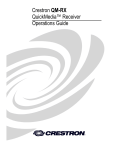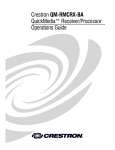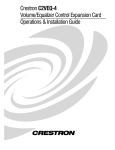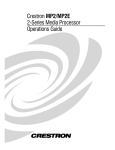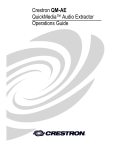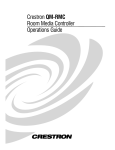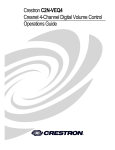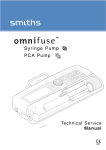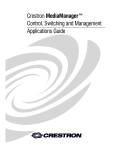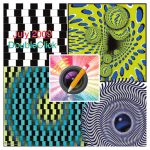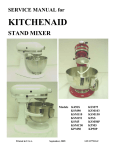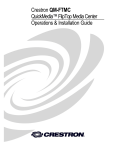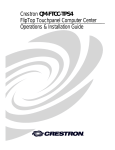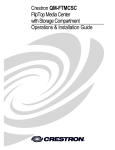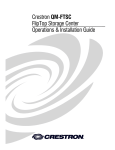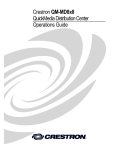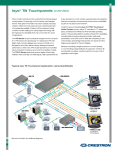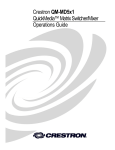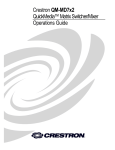Download Crestron QuickMedia QM-RX Specifications
Transcript
Crestron QM-RMCRX QuickMedia™ Receiver/Processor Operations Guide This document was prepared and written by the Technical Documentation department at: Crestron Electronics, Inc. 15 Volvo Drive Rockleigh, NJ 07647 1-888-CRESTRON All brand names, product names and trademarks are the property of their respective owners. ©2004 Crestron Electronics, Inc. Crestron QM-RMCRX QuickMedia Receiver/Processor Contents QuickMedia Receiver/Processor: QM-RMCRX 1 Introduction ..........................................................................................................1 Features and Functions...........................................................................1 Specifications .........................................................................................5 Physical Description...............................................................................6 Memory................................................................................................11 Industry Compliance ............................................................................13 Setup...................................................................................................................13 Network Wiring ...................................................................................13 QuickMedia Wiring .............................................................................14 Mounting..............................................................................................15 Hardware Hookup ................................................................................16 Power Supply .......................................................................................18 Establishing Communication with the QM-RMCRX .........................18 Troubleshooting Communications .......................................................22 Identity Code........................................................................................23 Establishing Console Mode on an Ethernet Slave................................23 Configuring the QM-RMCRX............................................................................24 Configuring with Crestron SystemBuilder...........................................25 Digital Media Tools™ .........................................................................27 Problem Solving .................................................................................................31 Troubleshooting ...................................................................................31 Further Inquiries...................................................................................34 Firmware Upgrades..............................................................................35 Future Updates .....................................................................................35 Appendix: SIMPL Windows Programming .......................................................36 Programming with SIMPL Windows...................................................36 Compiling and Uploading a Program to the Control System ...............47 Uploading Web pages to the QM-RMCRX .........................................48 Converting Programs and Modules Created for Other Systems...........49 Updating the Operating System ...........................................................51 Advanced Console Commands ............................................................52 Software License Agreement..............................................................................53 Return and Warranty Policies.............................................................................55 Merchandise Returns / Repair Service .................................................55 CRESTRON Limited Warranty ...........................................................55 Operations Guide – DOC. 6236 Contents • i Crestron QM-RMCRX QuickMedia Receiver/Processor QuickMedia Receiver/Processor: QM-RMCRX Introduction Features and Functions The QM-RMCRX combines a Crestron® 2-Series Ethernet-based control system with a QuickMedia™ input (receiver) and Cresnet® master port. The QMRMCRX is designed to mount at the projector or plasma display to provide local display control, LAN connectivity, and signal management. Functional Summary • Powerful 2-Series processor, based on Motorola’s ColdFire® technology, with non-volatile memory. • Supports DHCP, DNS, SSL (refer to the notes on page 4), and XPanel IE/EXE/PDA control (Crestron e-Control®2), and QuickMedia™ transport technology. • Flash memory, DRAM, and programmable logic via SIMPL Windows and SIMPL+®. • Two bi-directional COM ports (RS-232 only). • One IR port - compatible with Crestron ST-SPL IR-Splitter, for IRControl of up to five different devices, programmable via the hundreds of IR device drivers available in the Crestron database. • Four digital input ports for direct connection of power sensors, pressure sensors, door sensors, room occupancy sensor, etc. • A 10/100 Ethernet LAN port with built-in Web server/XPanel control, support for DHCP, all Crestron e-Control power applications and Crestron RoomView™ facility monitoring and management software. • Two Cresnet connectors. • Composite, S-video and RGBHV video outputs. • Volume, bass and treble controls. • Three line level outputs. • 20-watt stereo amplifier. • 12 band graphic/parametric equalizer for left program, right program, and speech. • Microphone mixer with up to 40 ms delay. • Power pack included. Operations Guide – DOC. 6236 QuickMedia Receiver/Processor: QM-RMCRX • 1 QuickMedia Receiver/Processor Crestron QM-RMCRX The QM-RMCRX processes standard video (i.e. DVD, VCR, camera video), RGB video and audio signals through its proprietary QuickMedia transport port. The QuickMedia connection port is a revolutionary signal processing system that allows for transmitting and receiving any signal type (including video, audio, computer and microphone signals) via CAT5E type cable. A QuickMedia Wall Plate (QM-WMC) converts these signals from analog to digital and transmits them to a QM-RMCRX receiver using a CAT5E cable (the signal skew of the cable must not be greater than 15 ns over the total length, refer to “Video Adjustments” on page 29 for additional skew information). The QuickMedia receiver performs frequency compensation on each twisted pair video input to maintain correct operation. The QM-RMCRX then converts each of those signal types back to standard analog signals for connection to a display (projector or flat-panel monitor), an audio amplifier, or if using the on-board amplifier, directly to speakers. QM-RMCRX outputs include: • RGB • Composite video • S-video • Two unbalanced line audio outputs or an unbalanced stereo line output • One unbalanced line-level speech output • One 20-watt stereo output, with built-in volume, bass and treble controls. The QM-RMCRX QuickMedia Receiver/Processor features onboard professional digital audio processing, with volume and tone control, 12-band graphic/parametric equalization, and up to 40 ms of delay for speech audio. The onboard mic mixer can mix the two remote microphones with stereo program signals in any proportion, so the sound is always precisely tailored to the listening environment. All the audio features of the QM-RMCRX are easily configurable using Crestron Digital Media Tools™ software. Using the sliders, you can adjust EQ filters and presets, input/output gain, and mixing levels. Select real time mode to hear the sound as it is adjusted and then create a configuration file ready to be uploaded to the QM-RMCRX. Video signals received by the QM-RMCRX are applied to the display device via the RGBHV, S-video, and composite video ports. Each video output port is switched for signal selection to match the selected input source of the QuickMedia transmitter (sold separately). The display device can also be addressed via the COM port to activate only the input of interest. Audio path routing is accomplished via mixer schemes. Refer to the following block diagram. 2 • QuickMedia Receiver/Processor: QM-RMCRX Operations Guide - DOC. 6236 Crestron QM-RMCRX QuickMedia Receiver/Processor QM-RMCRX Block Diagram The QM-RMCRX is an Ethernet control system that runs on the powerful 2Series processor, based on Motorola’s 32-bit ColdFire® technology. I/O options include two bi-directional COM ports, four digital inputs, two Cresnet ports, one IR port, and one 10/100 Ethernet port. The QM-RMCRX is shipped as a master controller, but may also be used as a slave. Refer to the latest version of the Crestron 2-Series Control Systems Master-Slave Mode Reference Guide (Doc. 6164), available on the Crestron website (www.crestron.com), for additional master-slave details. Operations Guide – DOC. 6236 QuickMedia Receiver/Processor: QM-RMCRX • 3 QuickMedia Receiver/Processor Crestron QM-RMCRX The QM-RMCRX provides an integrated Web server with SSL, allowing users to control AV devices from any computer on the LAN, WAN, or even custom web pages designed using Crestron VisionTools® Pro-e. With Crestron e-Control 2 XPanel technology, Web pages have the same look and feel as TPS touchpanel pages, with the same outstanding runtime performance. Crestron e-Control 2 also generates standalone XPanel programs that users can launch from their Windows® desktop or from Windows PocketPC 2002 PDA devices and Windows Tablet PCs. With built-in support for SSL, users can feel confident knowing that their Crestron e-Control 2 connection to the control system is secure and private. The QM-RMCRX supports all Crestron e-Control power applications, including Crestron RoomView™ software. Using Crestron RoomView, organizations can monitor multiple room A/V controllers on an Ethernet network, in real time, from any network PC. Crestron RoomView and the QM-RMCRX can provide remote power control and management of A/V devices, including monitoring lamp life of projectors, device status to ensure proper equipment operations, room occupancy, equipment use log, and device and room security. NOTE: DHCP (Dynamic Host Configuration Protocol) is a network protocol that enables a DHCP server to automatically assign an IP address to an individual computer's TCP/IP stack software. DHCP assigns a number dynamically from a defined range of numbers (i.e., a scope) configured for a given network. NOTE: DNS stands for Domain Name Service (or System). Its primary use is to translate, or resolve, the IP number for a computer (e.g., 129.79.5.208) from an alphanumeric name. NOTE: SSL, or Secure Socket Layer, is the most commonly used protocol for Web security. In addition to providing security for HTTP (Web hypertext) transactions, SSL works with other TCP/IP standards such as IMAP mail and LDAP directory access. For a security standard such as SSL to work, the browser and the Web server must both be configured to use it. SSL works by creating a temporary shared "key" that only allows the devices on either end of a transmission, to scramble and unscramble information. To anyone between the sender and the receiver, the SSL transmission is indecipherable. SSL uses certificates to verify that a device, browser or server is authentic. In addition, all data sent over an encrypted SSL connection is protected with a mechanism for detecting tampering — that is, for automatically determining whether the data has been altered in transit. Crestron's implementation of SSL supports selfsigned certificates and certificates issued by official Internet Certifying Authorities combined with assignable security levels and password protection. Crestron SSL integration uses the RSA 1024 bit Key Exchange Algorithm with a host of cipher suites. 4 • QuickMedia Receiver/Processor: QM-RMCRX Operations Guide - DOC. 6236 Crestron QM-RMCRX QuickMedia Receiver/Processor Specifications Specifications for the QM-RMCRX are given in the following table. QM-RMCRX Specifications SPECIFICATION DETAILS ® CPU 32-Bit Motorola 5272 ColdFire Processor Processor Speed 63 MIPS (Dhrystone 2.1 Benchmark) Memory 36MB (4 MB flash, 32 MB SDRAM, 256 KB NVRAM) Default Network ID Ports/Connectors 1 02 (shipped as control system master) 2 LAN One – RJ-45 10/100 BaseT, full duplex Ethernet port Default IP Ports: 80 = HTTP/Web Host, 41794 = Crestron, 41795 = Diagnostics/Viewport INFRARED – Serial Out One – 2-Position Mini connector IR port (Supports up to five IR devices) INPUT – Digital COM (A & B) One – 5-Position Mini connector (four inputs and GND) Two – DB9 bidirectional serial ports (RS-232) baud rate up to 115,200 bps (Port B is used for initial communication and setup). Refer to page 18. 24 VDC, 2 A One – Male receptacle for external power pack (included) Cresnet Two-4-pin mini connectors Composite Video Output One-BNC male connector S-video Output One-Mini-DIN 4-pin connector RGBHV Output One D15HD female connector Audio line level output One-6-pin mini connector Speaker output Two-2-pin connectors QuickMedia One QM RJ-45 connector Reset Buttons HW-R SW-R Initiates system hardware reset SIMPL Windows program restart. (If held at startup, bypasses program) Composite/S-video Video gain Bandwidth 0 dB (unity, double termination) >40 MHz (-3 dB) at unity gain RGB Video Gain 0 dB (unity, double termination) Maximum Resolution/Refresh Rate 1600 x 1200 @ 60 Hz, at unity gain, with cable length of 300 feet and maximum compensation at receiver. Bandwidth Compensation Digital control, 10-bit D/A Digital Gain Control 10-bit D/A (low frequency compensation) Propagation delay Compensation Digitally controlled delay line (4-bit control) Maximum Compensation 15 ns (for R, G, or B independently) Audio Line-Level Channels Maximum Line-Level output 2 VRMS per channel Output Impedance 100 Ω unbalanced Frequency Response 20 Hz to 20 kHz, +/- 0.5 dB Signal-to-Noise Ratio 20 Hz to 20 kHz A-weighted 94 dB Total Harmonic Distortion 20 Hz to 20 kHz 0.05% 1. For more information on system memory usage, refer to “Memory” on page 10. 2. For more information on controls, ports, and indicators, refer to the following “Physical Description”, which begins on the next page. Specifications continued on next page Operations Guide – DOC. 6236 QuickMedia Receiver/Processor: QM-RMCRX • 5 QuickMedia Receiver/Processor Crestron QM-RMCRX QM-RMCRX Specifications (continued) SPECIFICATION DETAILS Amplifier Output Amplified Audio 10 W maximum per channel into 4 or 8 Ω Frequency Response 20 Hz to 20 kHz, +/- 0.5 dB Signal-to-Noise Ratio 20 Hz to 20 kHz A-weighted 90 dB Total Harmonic Distortion 20 Hz to 20 kHz 0.7% Audio Switcher Processing Volume Control -80 dB to +20dB unbalanced input and output Bass/Treble Controls ±15 dB Selectable Equalization 3-band graphic plus 9-band parametric EQ 5-band graphic plus 7-band parametric EQ 5-band graphic plus 7-band parametric with speech optimization EQ 10-band graphic plus 2-band parametric Full 12-band parametric, no graphic equalizers Power Requirements 36 Watts (1.5 Amp @ 24 VDC) 60 Watt external power pack (PW-2420) supplied Initial Firmware Release 3.101 Environmental Temperature 41° to 104°F (5° to 40°C) Environmental Humidity 10% to 90% RH (non-condensing) Dimensions & Weight Height: Width: Depth: Weight: 2.45 in (6.22 cm) 7.53 in (19.13 cm) 5.24 in (13.30 cm) 2.20 lb (1.00 kg) Physical Description The QM-RMCRX is housed in a black enclosure with labeling on the front and rear panels. There are four rubber feet on the base of the unit for stability and to prevent slippage. Refer to the following illustrations and physical views. Front and Rear Views 6 • QuickMedia Receiver/Processor: QM-RMCRX Operations Guide - DOC. 6236 Crestron QM-RMCRX QuickMedia Receiver/Processor Physical Dimensions 2.45 in (6.22 cm) 2.30 in (5.84 cm) 5.24 in (13.30 cm) 7.53 in (19.13 cm) Front Panel Ports The QM-RMCRX front panel ports are illustrated and described as follows. 1 QM 8 QM Input Eight-pin RJ-45 QuickMedia transport port. Accepts CAT5E audio, video, microphone, and control signals. The QM input port conforms to the 568B wiring standard. Refer to page 14 for additional wiring information. Operations Guide – DOC. 6236 QuickMedia Receiver/Processor: QM-RMCRX • 7 QuickMedia Receiver/Processor NET 24 Y Z G Crestron QM-RMCRX NET 24 Y Z G These connectors are used for expansion to Cresnet peripherals. Power to the unit can be supplied through this connector. 24 VDC 2.0 A 24VDC, 2.0A (Power Supply) This male connector can be used to supply 24 VDC power to the QM-RMCRX from an external power pack (included). CAUTION: Use only Crestron power supplies for Crestron equipment. Failure to do so could cause equipment damage or void the Crestron warranty. LAN Green Yellow 8 L + - 1 SPEAKER LAN An 8-position RJ-45 port (labeled LAN) is used for connection to the Ethernet, providing local area network or Web access (cable is not supplied). The port also contains two light-emitting diodes (LEDs). The green LED on the right side of the port is a link status LED and illuminates when the card is connected to a working network. The yellow LED on the left side flashes to indicate Ethernet activity. Refer to the following table for the Ethernet connector signals and use an appropriate cable. Refer to “TCP/IP Connection” on page 20 for the RJ-45 connector pinouts. SPEAKER R + - Two 2-pin terminal block connectors, 5 mm spacing. Left and right amplified stereo audio output, 10 watts per channel into 4 or 8 ohms. Rear Panel Ports The QM-RMCRX rear panel ports are illustrated and described as follows. S-Video S-VIDEO Pin 4 Pin 3 One DIN type connector for S-video output. S-Video Connector Pinout Pin 2 Pin 1 PIN DESCRIPTION 1 Ground 2 Ground 3 Luminance 4 Chrominance NOTE: S-video contains two separate components, luminance and chrominance (also known as Y and C signals respectively). The luminance signal contains brightness, intensity, and signal timing information. This signal contains all picture information except for color. The chrominance signal contains only the color information. You can see the complete black and white image, without the chrominance, by only feeding the luminance signal into a monitor. 8 • QuickMedia Receiver/Processor: QM-RMCRX Operations Guide - DOC. 6236 Crestron QM-RMCRX VIDEO QuickMedia Receiver/Processor Composite Video One BNC type connector for composite video output. NOTE: Composite video is a type of video signal in which all of the video information, the red, green, and blue (horizontal and vertical sync) signals are mixed together. 1 RGBHV 10 RGBHV One DB15HD male connector for RGB video output. DB15HD Connector Pinout PIN 15 DESCRIPTION PIN DESCRIPTION 1 Red Signal 9 2 Green Signal 10 N/C Sync Ground 3 Blue Signal 11 ID0 (Ground) 4 Reserved 12 ID1 (No Connection) 5 Ground 13 Horizontal Sync 6 Red Ground 14 Vertical Sync 7 Green Ground 15 No Connection 8 Blue Ground NOTE: RGB is a computer signal that uses the standard High Density (HD15) 15-pin connector. It is comprised of three analog video signals: red, green, blue and separate horizontal and vertical syncs. Most computer monitors use RGB (usually called VGA, SVGA, XVGA, etc.). RGBHV consists of red, green, blue, horizontal sync and vertical sync. NOTE: Some DLP display devices are extremely sensitive to noise. The antialiasing filter included with the QM-RMCRX may be used at the RGBHV output or on the display device input. AUDIO SPCH L R S G S G S G Audio Line Level One 6-pin mini connector. Three unbalanced line level outputs: Speech (SPCH), Left (L) and Right (R). INPUT 1234G INPUT This connector provides four software programmable digital inputs. Inputs are Schmidt trigger type (nominal 2.5 V threshold) with 24 V input tolerance. For detailed information, refer to “Slot 2: C2I-RMC-DI4” on page 37. Digital inputs are rated 0 – 24 VDC, 20K ohms input impedance. IR S G IR A 2-position mini-connector is a mini-implementation of a single PRO2 IR port. The output is labeled S (signal) and G (ground). Infrared output is rated up to 1.2 MHz. Serial protocol is one-way RS-232. For detailed information, refer to “Slot 1: C2I-RMC-IR1” on page 37. Operations Guide – DOC. 6236 QuickMedia Receiver/Processor: QM-RMCRX • 9 QuickMedia Receiver/Processor COM A COM B Crestron QM-RMCRX COM (A & B) These two DB9 (male) software programmable, bi-directional serial ports are available for RS-232 communication, with hardware and software handshaking and modem control. Speeds are rated up to 115,200 bps. COM B can also be used as the console port. (Null modem cable is required to connect to a computer.) NOTE: RS-422 and RS-485 are not supported. Standard COM DB9 Pinout PIN DIRECTION DESCRIPTION 1 TO QM-RMCRX (DCD) Data Carrier Detect 2 To QM-RMCRX (RXD) Receive Data 3 From QM-RMCRX (TXD) Transmit Data 4 From QM-RMCRX (DTR) Data Terminal Ready 5 Common (SG) Signal Ground 6 From QM-RMCRX (DSR) Data Set Ready 7 From QM-RMCRX (RTS) Request To Send 8 To QM-RMCRX (CTS) Clear To Send 9 To QM-RMCRX (RI) Ring Indicator Indicators The QM-RMCRX front panel indicators are described as follows. COM A This red LED indicates COM A port activity. COM B This red LED indicates COM B port activity. Constant blinking indicates that the port is used for remote console connection. IR This red LED indicates IR port activity. INPUT This red LED indicates input activity. PWR (Power) This green LED illuminates when the unit is connected to and receives 24 VDC power from an external power pack or from Cresnet. ACT (LAN) This yellow LED illuminates when the QM-RMCRX communicates with any device on the network. 10 • QuickMedia Receiver/Processor: QM-RMCRX Operations Guide - DOC. 6236 Crestron QM-RMCRX QuickMedia Receiver/Processor NET (Cresnet) This yellow LED illuminates when the QM-RMCRX communicates with Cresnet devices on the network, and also indicates that the SIMPL Windows program currently loaded has a network device defined at the same network ID as the QM-RMCRX. Reset Buttons Two buttons are provided on the front panel of the QM-RMCRX. Refer to the following descriptions. HW-R Pressing this button initiates system hardware reset. (Same effect as disconnecting and reconnecting power.) SW-R Pressing this button in combination with the HW-R button performs a system restart without loading the program (refer to “Troubleshooting Communications” on page 22). Press HW-R momentarily while pressing and holding SW-R to reboot. Pressing SW-R alone while the system is running restarts the program. Serial console connection may be established if SW-R button is pressed and held about five to seven seconds during power up (wait for Viewport to display some information), or if pressed and held at the same time HW-R is momentarily pressed. The serial console mode is also established if the processor is configured as a master, but has no program loaded. In this way, the console mode is enabled out-of-the-box and the user does not have to perform any special steps to initially configure the processor. NOTE: The COM B LED will flash when in the console mode. To terminate the console mode, press the HW-R button or cycle the power. NOTE: Pressing <F10> (Program Reset) in Viewport may cause errors if both the program and the console mode are using the same COM port. Memory The QM-RMCRX has 36 MB of built-in memory (non-volatile and volatile). The total of 36 MB is specified as follows: 4 MB flash (non-volatile), 32 MB SDRAM (volatile), and 256 KB NVRAM (battery backed up). Flash memory contains the file system inside the 2-Series control engine. Non-volatile memory contains information that is retained after the loss of electrical power. Volatile memory is lost after a power failure. Refer to the following lists for a breakdown of memory usage for program-related information stored in the unit. Flash Operations Guide – DOC. 6236 1. SIMPL Program (.smw) 2. SIMPL+ Modules (.usp/.ush) 3. Operating System (.cuz file) QuickMedia Receiver/Processor: QM-RMCRX • 11 QuickMedia Receiver/Processor Crestron QM-RMCRX The 4 MB flash memory consists of approximately 1.5 MB used for firmware, and approximately 2.5 MB available for SIMPL, SIMPL+, and Web pages. The files that reside in flash conform to a flat directory structure. The following table presents the structure of the overall file system. Flash File Structure TOP LEVEL SECONDARY LEVEL \ DESCRIPTION Root of the file system DISPLAY SYS SETUP Legacy directory used in Crestron Isys® panels to hold display lists Contains various system configuration files Contains web-based setup pages HTML Web pages SIMPL Control system program files SPLUS SIMPL+ module files USER Used for user-defined files MAILBOX \nvram Directory contains the user mailbox file The mounting point for NVRAM disk files (if configured) Although the file system is case insensitive, the case is preserved to maintain file checksums. Non-volatile 1. SIMPL+ Variables (Default if no options are specified, or using "nonvolatile" qualifier or #DEFAULT_NONVOLATILE) 2. Signals explicitly written to NVRAM* (by symbols such as Analog RAM, Analog RAM from database, Serial RAM, Serial RAM from database, Analog Non-volatile Ramp, Digital RAM, etc.) *Commonly used for presets (volume/lighting/dial #s). 3. Portions of the NVRAM may be set aside for implementing an “NVRAM Disk”. This can be used to provide file system access from SIMPL+. NOTE: If you extract NVRAM values to a file (Viewport, File transfer | Save NVRAM to File), to simplify restoring them in the event of file corruption or to distribute to identical control systems, remember that NVRAM values are position sensitive in the program. When saving the NVRAM is crucial to your application, it is recommended to place all symbols and/or modules that use NVRAM at the beginning of your program. When NVRAM (.nvr file) is re-installed, all the values should line up with the program. If the program is modified, and new logic that uses NVRAM is placed before any older symbols using NVRAM, the previously stored values will not line up and your presets will have to be re-entered. Volatile (DRAM) 1. Digital, analog and serial signal values 2. SIMPL+ Variables (if "volatile" qualifier is used, or #DEFAULT_VOLATILE is used) 12 • QuickMedia Receiver/Processor: QM-RMCRX Operations Guide - DOC. 6236 Crestron QM-RMCRX QuickMedia Receiver/Processor DRAM is used by the operating system for dynamic storage of variables, signals and other constructs used at runtime. The actual amount of DRAM used at any given time depends on the particular program that is running, i.e., usage is variable, or dynamic, during normal operation. Industry Compliance As of the date of manufacture, the QM-RMCRX has been tested and found to comply with specifications for CE marking and standards per EMC and Radiocommunications Compliance Labelling (N11785). NOTE: This device complies with part 15 of the FCC rules. Operation is subject to the following two conditions: (1) this device may not cause harmful interference, and (2) this device must accept any interference received, including interference that may cause undesired operation. Setup Network Wiring NOTE: When installing network wiring, refer to the latest revision of the wiring diagram(s) appropriate for your specific system configuration, available from the Downloads | Product Manuals | Wiring Diagrams section of the Crestron website (www.crestron.com). When calculating the wire gauge for a particular Cresnet run, the length of the run and the power factor of each network unit to be connected must be taken into consideration. If Cresnet units are to be daisy-chained on the run, the power factor of each unit to be daisy-chained must be added together to determine the power factor of the entire chain. If the unit is a home-run from a Crestron system power supply network port, the power factor of that unit is the power factor of the entire run. The length of the run in feet and the power factor of the run should be used in the following resistance equation to calculate the value on the right side of the equation. Resistance Equation R < 40,000 L x PF Where: R = Resistance (refer to table below). L = Length of run (or chain) in feet. PF = Power factor of entire run (or chain). The required wire gauge should be chosen such that the resistance value is less than the value calculated in the resistance equation. Refer to the following table. Operations Guide – DOC. 6236 QuickMedia Receiver/Processor: QM-RMCRX • 13 QuickMedia Receiver/Processor Crestron QM-RMCRX Wire Gauge Values RESISTANCE WIRE GAUGE 4 16 6 18 10 20 15 22 13 Doubled CAT5 8.7 Tripled CAT5 NOTE: All Cresnet wiring must consist of two twisted-pairs. One twisted pair is the +24V conductor and the GND conductor and the other twisted pair is the Y conductor and the Z conductor. NOTE: When daisy-chaining Cresnet units, strip the ends of the wires carefully to avoid nicking the conductors. Twist together the ends of the wires that share a pin on the network connector, and tin the twisted connection. Apply solder only to the ends of the twisted wires. Avoid tinning too far up the wires or the end becomes brittle. Insert the tinned connection into the Cresnet connector plug and tighten the retaining screw. Repeat the procedure for the other three conductors. NOTE: When using CRESCAT-QM cable, four wires are provided for Cresnet connections and four wire pairs are provided for QuickMedia CAT5E wiring. QuickMedia Wiring The Crestron QuickMedia cable (sold by Liberty Wire and Cable under the name “CRESCAT-QM”) contains one CAT5E cable and one Cresnet® cable in siamese jackets. Installation of any QuickMedia device is as simple as installing one set of QuickMedia wires from input to output. Installations are flexible, affordable, and fast. CRESCAT-QM Cable Cresnet CAT5 Pair 1 Blue-Blue/White CRESCAT-QM Cable CAT5 Pair 2 Orange-Orange/White CAT5 Pair 3 Green-Green/White CAT5 Pair 4 Brown-Brown/White 14 • QuickMedia Receiver/Processor: QM-RMCRX Operations Guide - DOC. 6236 Crestron QM-RMCRX QuickMedia Receiver/Processor NOTE: Do not untwist the two wires in a single pair for more than 1/3-1/2" (0.84 – 1.27 cm) when making a connection. The twists are critical to canceling out interference between the wires. The QuickMedia transport mechanism (receiver) performs frequency compensation on each video input to compensate for skew. Signal skew occurs when part of the signal is delayed with respect to other signal components. The amount of skew largely depends on the length of the wire. Because CAT5 consists of twisted pairs that are twisted together in the cable, unequal wire lengths are created. The total accumulated skew from source to receiver must not exceed 15 ns (nanoseconds). Crestron recommends a cable rating of 15 ns per 100 m (328 ft.). For example, connecting the QM-WMC with 150 ft. of cable to a QM-MD-8x8, and then using another 150 ft. to connect the QM-RMCRX, the accumulated skew must not exceed 15 ns. Longer lengths of cable may experience a loss of bandwidth when viewing at high video resolutions. The pin assignment is based on the EIA/TIA 568B RJ-45 Jack standard. The following table illustrates how composite, S-video, and RGB video signals are transmitted over the CAT5E wire. RJ-45 QuickMedia Connector Pin and Pair Assignment RJ-45 PIN NUMBER CAT5E PAIR NUMBER 1 Pin 1 WIRE COLORS (EIA 568B) QM ASSIGNMENT RGB AND AUDIO QM ASSIGNMENT COMPOSITE, S-VIDEO AND AUDIO 2 WHITE/ORANGE - RGB RED - CHROMINANCE 2 2 ORANGE + RGB RED + CHROMINANCE 3 3 WHITE/GREEN - RGB GREEN - LUMINANCE 4 1 BLUE + AUDIO + AUDIO 5 1 WHITE/BLUE - AUDIO - AUDIO 6 3 GREEN + RGB GREEN + LUMINANCE 7 4 WHITE/BROWN - RGB BLUE - COMPOSITE 8 4 BROWN + RGB BLUE + COMPOSITE Mounting The QM-RMCRX can be mounted using the included four mounting brackets. Attach the included brackets using the existing cover screws located on the sides of the QM-RMCRX as shown in the following diagram. Operations Guide – DOC. 6236 QuickMedia Receiver/Processor: QM-RMCRX • 15 QuickMedia Receiver/Processor Crestron QM-RMCRX Mounting Positions of the Four Included Mounting Brackets 8.53 in (21.67 cm) 4.56 in (11.58 cm) NOTE: The MK-QM-RMCRX mounting kit is available for mounting the QMRMCRX to a pipe. Details can be found in the latest version of the MK-QMRMCRX Installation Guide (Doc. 6247). Hardware Hookup Refer to the following hookup diagram and, aside from attaching power last, complete the connections in any order. NOTE: To prevent overheating, do not operate this product in an area that exceeds the environmental temperature range listed in the specifications table. Consideration must be given if installed in a closed or multi-unit rack assembly since the operating ambient temperature of the rack environment may be greater than the room ambient. Contact with thermal insulating materials should be avoided on all sides of the unit. NOTE: The maximum continuous current from equipment under any external load conditions shall not exceed a current limit that is suitable for the minimum wire gauge used in interconnecting cables. The ratings on the connecting unit's supply input should be considered to prevent overloading the wiring. 16 • QuickMedia Receiver/Processor: QM-RMCRX Operations Guide - DOC. 6236 Crestron QM-RMCRX QuickMedia Receiver/Processor Front Connections ETHERNET: 10/100 BASE-T ETHERNET TO LAN CRESNET: TO CONTROL SYSTEM* AND OTHER CRESNET DEVICES QM INPUT: QUICKMEDIA PORT RECEIVES AUDIO, VIDEO, RGB, AND MICROPHONE SIGNALS POWER: FROM POWER PACK (24 VDC, 2.0 A) SPEAKER: AMPLIFIED STEREO AUDIO OUTPUT * CONNECTS TO CONTROL SYSTEM WHEN IN SLAVE MODE. Rear Connections VIDEO OUTPUT: TO DISPLAY DEVICE Ground (S-VIDEO) AUDIO OUTPUT: (UNBALANCED LINE LEVEL) y SPEECH y LEFT y RIGHT (COMPOSITE) DIGITAL INPUTS: FOUR SCHMIDT TRIGGER TYPE FROM CONTACT CLOSURE DEVICES IR: TO IRP2 OR SERIAL DEVICE (RGBHV) COM: BI-DIRECTIONAL RS-232 WITH HARDWARE & SOFTWARE HANDSHAKING AND MODEM CONTROL NOTE: COM B is shared for device control and serial console connection. Set to console mode using the procedure on page 18. NOTE: Use either the internal amplifier (SPEAKER) output or the AUDIO left and right line outputs, but not both. Using both induces noise. NOTE: Proper grounding is required. Connect the ground wires from the QM transmitter (QM-WMC/QM-WMIC) to earth ground. Connect the Cresnet shield at the QM-RMCRX to the chassis ground provided on the QM-RMCRX. The Operations Guide – DOC. 6236 QuickMedia Receiver/Processor: QM-RMCRX • 17 QuickMedia Receiver/Processor Crestron QM-RMCRX QM-RMCRX chassis must also be connected to an earth ground (building steel). Refer to the following grounding diagram. Grounding Diagram QM-RMCRX Ground Wire to Earth Ground 24 Y Z G QM-WMC QM-WMIC Shield Cresnet Ground Wire Ground Wire to Earth Ground Power Supply The QM-RMCRX can be powered through the NET network connector, or by the external PW-2420 power pack (60W) included but not by both methods. Use the provided external power pack to provide power to peripheral Cresnet devices (via the Cresnet connector). If additional power is needed, Crestron recommends its CNPWS-75 (75 watts) external power supply. CAUTION: Use only Crestron power supplies for Crestron equipment. Failure to do so could cause equipment damage or void the warranty. NOTE: Use care in wiring installations to avoid applying 24 VDC power to Cresnet wiring from an external power pack as well as from a system device that contains its own power supply. Although this condition should not cause any damage, Crestron does not recommend it. NOTE: In larger system configurations that require more power than supplied by Cresnet, disconnect the +24 VDC wire from the QM-RMCRX Cresnet connector and provide the +24 VDC power to the peripheral devices by an alternate Crestron power source. Establishing Communication with the QM-RMCRX Before uploading a program to the QM-RMCRX or performing diagnostic functions, you must connect the QM-RMCRX system to the PC. The connection can be either serial or TCP/IP. NOTE: For laptops and other PCs without a built-in RS-232 port, Crestron recommends the use of PCMCIA cards, rather than USB-to-serial adapters. If a USB-to-serial adapter must be used, Crestron has tested the following devices with good results: Belkin (large model) F5U103 I/O Gear GUC232A Keyspan USA-19QW Other models, even from the same manufacturer, may not yield the same results. 18 • QuickMedia Receiver/Processor: QM-RMCRX Operations Guide - DOC. 6236 Crestron QM-RMCRX QuickMedia Receiver/Processor Serial Connection Null Modem Cable Pins Pins 2 2 3 3 5 5 7 7 8 8 Connect the COM B port on the QM-RMCRX control system to one of the COM ports (usually COM 1) on the PC. The QM-RMCRX requires the use of a null-modem RS-232 cable with DB9 female connectors on both ends. Most commercially available cables are acceptable; they should have at least five pins for transmit, receive, ground, and hardware handshaking (pins 2, 3, 5, 7 and 8). Serial console connection may be established only if SW-R button is pressed and held about 5 to 7 seconds during power up (wait for Viewport to display some information), or if pressed and held at the same time HW-R is momentarily pressed. The serial console mode is also established if the processor is configured as a master, but has no program loaded. In this way, the console mode is enabled out-of-the-box and the user does not have to perform any special steps to initially configure the processor. NOTE: The COM B LED will flash when in the console mode. NOTE: The Viewport utility performs multiple system tasks, primarily via an RS-232 or TCP/IP connection between the control system and a PC. It is used to observe system processes, upload new operating systems and firmware, change system and network parameters, and communicate with network device consoles and touchpanels, among many other tasks. Viewport can also function as a terminal emulator for generic file transfer. All of these functions are accessed through the commands and options in the Viewport menus. Therefore, for its effectiveness as a support and diagnostic tool, the Crestron Viewport may be preferred over development tools when uploading programs and projects. Open the Crestron Viewport and click Setup | Communication Settings to display the “Port Settings” window. Then click RS-232 as the connection type. The PC communication settings specified here should match the protocol that the QM-RMCRX expects. The settings are as follows: Operations Guide – DOC. 6236 • Port = COM 1 through COM 8. Select the correct COM port on the PC. • Baud rate = 115200 (You can set the PC and the control system to a different baud rate, by using the Functions | Set Baud Rate command. • Parity = None. • Number of data bits = 8. • Number of stop bits = 1. • Hardware handshaking (RTS/CTS) enabled. • Software handshaking (XON/XOFF) not enabled. QuickMedia Receiver/Processor: QM-RMCRX • 19 QuickMedia Receiver/Processor Crestron QM-RMCRX “Port Settings” Window: Default PC Settings for RS-232 Communication with the QM-RMCRX To verify communication, click Diagnostics | Establish Communications (Find Rack). This should display a window that gives the COM port and baud rate. To terminate the serial console mode, press the HW-R button or cycle the power. NOTE: Pressing <F10> (or selecting Functions | 2-Series | Program Reset) in Viewport may cause errors if both the program and the console mode are using the same COM port. TCP/IP Connection Before you can communicate with the QM-RMCRX over TCP/IP, you must use the RS-232 connection just described to configure the unit’s TCP/IP settings. Obtain the static address from the network administrator. 1. Open Viewport and click Functions | Set Control System IP Information. 2. Enter the IP address, IP mask and default router in the text fields. All of these terms are explained in detail in the Crestron e-Control Reference Guide, Doc. 6052. The latest version is available as a PDF on the Crestron website (www.crestron.com). 3. Click OK to set the new IP information. Once you have assigned the IP settings, you can continue to communicate with the QM-RMCRX using the RS-232 connection, or you can establish a TCP/IP connection. For TCP/IP, use CAT5 straight through cables with 8-pin RJ-45 connectors to connect the LAN port on the QM-RMCRX and the LAN port on the PC to the Ethernet hub. Alternatively, you can use a CAT5 crossover cable to connect the two LAN ports directly, without using a hub. The following figure illustrates pinouts for straight through and crossover RJ-45 cables. Pins 4, 5, 7, and 8 are not used. 20 • QuickMedia Receiver/Processor: QM-RMCRX Operations Guide - DOC. 6236 Crestron QM-RMCRX QuickMedia Receiver/Processor RJ-45 Pinouts Once the cable connections are made, open the Crestron Viewport and click Setup | Communication Settings on the menu to display the “Port Settings” window. Then click TCP/IP as the connection type. Enter the IP address of the QM-RMCRX. “Port Settings” Window To verify communication, click Diagnostics | Establish Communications (Find Rack). This should display a window that gives the IP address and port number. NOTE: To define the setup of DHCP-based Ethernet communication, refer to the Crestron e-Control Reference Guide (Doc. 6052). NOTE: When using Viewport/Test Manager via the Ethernet, the default Crestron Terminal Port (CTP) is 41795. NOTE: Default Ethernet Ports: 80 = Web 41794 = Crestron Com 41795 = Viewport/Debug Operations Guide – DOC. 6236 QuickMedia Receiver/Processor: QM-RMCRX • 21 QuickMedia Receiver/Processor Crestron QM-RMCRX Troubleshooting Communications Use the following checklist if communication cannot be established with the QM-RMCRX. 1. Verify that you are using the correct cables. As described previously, an RS-232 connection requires a null modem RS-232 cable with DB9 female connectors on both ends. TCP/IP connection requires a CAT5 cable with 8-pin RJ-45 connectors. 2. With a serial connection, verify that the correct COM port on the PC has been selected. Some computers have more than one COM port; some may be internal (e.g., for a modem). Consult the manufacturer’s documentation for further information about the COM ports on your PC. 3. Ensure that you have a serial connection to Port B, and reset the control system as follows: a. Open Viewport and click Setup | Communications Settings to display the “Port Settings” window. Choose RS-232 as the connection type. b. Set the baud rate of the PC to 115200. c. Set the baud rate of the QM-RMCRX control system to 115200, as follows: - Press and release the HW-R button on the unit’s front panel. - Press and hold the SW-R button for approximately three to five seconds. The Viewport console should display the following message: Viewport Message QMRMCRX> Control Console Changing to default Comm Specs. 115200 N81 RTS/CTS Switch to new settings…. Bypassing Program Load!!! d. e. Release the SW-R button. If communication still cannot be established: - Remove power from the control system. - Press and hold the SW-R button on the front panel of the QMRMCRX. - Reapply power to the control system. - The Viewport console should display the message shown above. - Release the SW-R button. Select Set Baud Rate on the Viewport Functions menu (or press F8) and choose any baud rate from the drop-down list. This will attempt to establish a connection at the indicated baud rate. If the connection is successful, both the PC and the control system will be set to the new baud rate. The QM-RMCRX will return to its original communication settings when the program reinitializes. 22 • QuickMedia Receiver/Processor: QM-RMCRX Operations Guide - DOC. 6236 Crestron QM-RMCRX QuickMedia Receiver/Processor f. Reinitialize the unit by recycling the power or pressing the HW-R button while pressing and holding the SW-R button. If the connection is established, the Viewport console should display some text and the QMRMCRX> prompt. g. If communication still cannot be established, contact Crestron customer service. Identity Code Every equipment and user interface within the network requires a unique identity code (Net ID). These codes are two-digit hexadecimal numbers from 03 to FE. The Net ID of each unit must match an ID code specified in the SIMPL Windows program. In slave mode, the QM-RMCRX operates as a 2-Series control system Cresnet or Ethernet device. For example, the QM-RMCRX can be part of a larger master control system that includes: audio and video switching, IR and relay control, and Ethernet, using touchpanels to operate the QM-RMCRX slave through the master 2-Series control system. To operate the QM-RMCRX as a slave, the Cresnet ID must be set to 03 or higher. From the Viewport console, type: CNETID XX (Where “XX” is any valid Cresnet ID (any number from 03 to FE is designated as a slave mode). NOTE: When in slave mode, the QM-RMCRX cannot address any Cresnet device on the operating network (only the controlled devices connected to the local ports of the slave). Only the master control system can address Cresnet devices. NOTE: When operating in the slave mode, any program loaded in the QMRMCRX will not run. NOTE: When operating in the slave mode, The QM-RMCRX is controlled by a 2-Series master control system only. NOTE: When operating in the slave mode, Viewport functions (firmware upgrades, passthrough mode) can be used on the slave device. Establishing Console Mode on an Ethernet Slave Entering serial console mode on an Ethernet slave is no different than on a master processor: hold down the SW-R button while booting up. Once you enter serial console mode, the COM B LED will flash. Please be aware that doing this causes the processor to boot up in standalone mode, rather than Ethernet slave mode. You will notice that the Ethernet master shows this device as being off-line. To put the processor back in Ethernet Slave mode and use the serial console, type: REBOOT at the console prompt. This will reboot the processor in slave mode, and enable the serial console. NOTE: Booting up in serial console mode will render COM B useless to the program, as it is being used for the serial console. Operations Guide – DOC. 6236 QuickMedia Receiver/Processor: QM-RMCRX • 23 QuickMedia Receiver/Processor Crestron QM-RMCRX To terminate the serial console mode, press the HW-R button, or cycle the power. NOTE: Pressing <F10> (or selecting Functions | 2-Series | Hard Reset) in Viewport for the master control system may cause errors if both the program and the console mode are using the same COM port. For more information on slave mode operation, refer to the latest revision of the 2-Series Master/Slave Modes Reference Guide (Doc. 6164). Configuring the QM-RMCRX Have a question or comment about Crestron software? Answers to frequently asked questions (FAQs) can be viewed in the Online Help section of the Crestron website (www.crestron.com). To post a question or view questions you have submitted to Crestron’s True Blue Support, log in at http://www.crestron.com/accounts/login.asp. First-time users will need to establish a user account. Use the Crestron programming tools Crestron SystemBuilder™ and Crestron Digital Media Tools™ to create a control program for the QM-RMCRX control system. The higher level of SIMPL Windows flexibility requires a much greater degree of programming expertise and is not recommended for this application. However, complete SIMPL Windows information is included in the Appendix of this Operation Guide. Use the advanced techniques available in SIMPL Windows to customize the job only if necessary. Earliest Version Software Requirements for the PC NOTE: Crestron recommends that you use the latest software to take advantage of the most recently released features. The latest software is available from the Downloads | Software Updates section of the Crestron website (www.crestron.com). Following are the minimum software requirements for the PC: • SIMPL Windows version 2.05.17. (Also requires SIMPL+ Cross Compiler version 1.1 or later). • Crestron Digital Media Tools™ version 2.0 or later for simplified audio control. • Crestron Database version 16.0.5 or later for use with SIMPL Windows, VT Pro-e, and Crestron SystemBuilder • (Optional, but highly recommended) Crestron SystemBuilder™ version 1.0 software or later for automatic residential and commercial programming of the QM-RMCRX as a control system. As of press time, this version of Crestron SystemBuilder had not been released. Please check the Crestron FTP site. • (Optional, for use with Crestron SystemBuilder) Crestron VisionTools Pro-e software version 3.2.0.0 or later for designing touchpanel and 24 • QuickMedia Receiver/Processor: QM-RMCRX Operations Guide - DOC. 6236 Crestron QM-RMCRX QuickMedia Receiver/Processor XPanel pages, and to use templates required for Crestron SystemBuilder. Configuring with Crestron SystemBuilder NOTE: The QM-RMCRX is configured with Crestron SystemBuilder version 1.0 software. As of press time, this version of Crestron SystemBuilder had not been released. Please check the Crestron FTP site. The Crestron SystemBuilder interface guides you through a few basic steps for specifying the control system, designating rooms and touchpanels, devices, and functionality. The Crestron SystemBuilder then configures the system, including all touchpanel projects and control system logic. The Crestron SystemBuilder is fully integrated with the Crestron suite of software development tools, including SIMPL Windows, Cross Compiler, VT Pro-e, Crestron Database, User IR Database, and User Modules Directory. The Crestron SystemBuilder accesses these tools behind the scenes, enabling you to easily create robust systems. SystemBuilder provides a step-by-step process that guides the user through the process of selecting components and determining signal routing and control. The control code and complete equipment lists are automatically generated. Crestron SystemBuilder automatically compiles and uploads your program to the control system. SystemBuilder When you click New, you can choose the QuickMedia Solutions tab. This tab offers a choice of wizard solutions. Choose the Single Origination Point wizard for the QM-RMCRX. Operations Guide – DOC. 6236 QuickMedia Receiver/Processor: QM-RMCRX • 25 QuickMedia Receiver/Processor Crestron QM-RMCRX Single Origination Point Wizard – Display control programming, including audio and video routing, using a keypad, touchpanel or PC, and having a single QuickMedia origination point (QM-WMC) connected to a single QuickMedia destination (QM-RMCRX). The wizard interface guides you through a few basic steps. • Name and Location – Allows you to select a processor, select a name for the system, and select the file location. • Display Device – The Display Device window is where you select the controlled display device, and the specific switching commands, that will be part of the system. • Display Options – Use this window to include screen and lift control as applicable. • QM Transmitter – Choose QM-WMC or QM-WMIC. • Room Options – Permits the use of RoomView management software, and sets the administrator and user passwords. • Audio Options – Type of audio, program source or program and speech source. • User Interfaces – Button layout and designations. • Controlled Sources –Select source devices from the extensive database and assign control parameters. • Video Options – Choose how the sources will be connected to the system and choose automatic system power on/off options. • Power Control – Use this window to setup power control for the display device. 26 • QuickMedia Receiver/Processor: QM-RMCRX Operations Guide - DOC. 6236 Crestron QM-RMCRX QuickMedia Receiver/Processor Single Origination Point Start Window After entering the appropriate information in each step, SystemBuilder creates the control system logic and touchpanel pages, ready to upload to the controller. NOTE: After uploading the program to the control system and installing the hardware, you can reset the values for properties such as volume, balance, treble and bass. Additional functionality, components, and control refinements can be made in SystemBuilder. • Add additional interfaces (keypads, touchpanels, etc.) • Add additional devices and A/V sources • Modify the sequences • Modify the home page through VisionTools Pro-e For additional details, download SystemBuilder from the Crestron website (www.crestron.com) and examine the extensive help file. Digital Media Tools™ Digital Media Tools™ (DMT) is the industry's most complete graphical Windows® programs for configuring high quality audio. Crestron makes it easy to customize the audio environment with Digital Media Tools software. Drag sliders and adjust waveforms to set EQ filters, gains, speaker configurations and delays. Select real time mode to hear the sound from each speaker as it is adjusted, and automatically create a configuration file ready for uploading. NOTE: The use of SIMPL Windows to adjust audio and setup video is not recommended. DMT offers three different setup procedures, depending on the type of QM equipment in your system. Operations Guide – DOC. 6236 QuickMedia Receiver/Processor: QM-RMCRX • 27 QuickMedia Receiver/Processor Crestron QM-RMCRX • QM-RX/QM-RMCRX with QM-WMC/QM-WMIC • QM-RMCRX only • QM-WMC/QM-WMIC only The QM-RMCRX Digital Media Tools adjustment contains the following nine tabs. • Microphone EQ - Adjusts trim presets for the microphones • Switcher - Sets up the video switching • Mixer - For mixing the audio inputs • Input Settings - Permits you to set the level for up to 192 different inputs • Output Graphic EQ - Adjusts the output using graphic EQ • Parametric EQ - Adjusts the output using parametric EQ • Output Settings - Enables the internal amplifier and sets up delay to overhead speakers • Video Setup - Adjusts the video signal for skew and white/black streaking • Communications - For setting up communications with the control system When using the second setup procedure that includes the QM-WMIC, an additional tab is used to adjust microphone gain, noise gating, attack and decay, and also provides a real-time audio monitor. Available Audio Filters A total of 12 filters for the right channel, 12 for the left channel and 12 filters for the microphone channels are provided, with five modes of audio equalization. • If you are using a 10-band graphic equalizer, the first ten filters in both the left and right channel are used to set up the default frequencies for the graphic equalizer, leaving two remaining parametric filters (11 and 12), in case you want to notch out a 60 Hz hum or other resonant frequency. • If you are using a 3-band graphic equalizer, the first three filters are used to set up the default frequencies for the graphic equalizer, leaving nine remaining parametric filters. • If you are using a 5-band graphic equalizer, the first five filters are used to set up the default frequencies for the graphic equalizer, leaving seven remaining parametric filters. • If you are using a 5-band speech optimized graphic equalizer, the first five filters re used to set up the graphic equalizer within the frequency ranges of the human voice. This leaves the remaining seven filters to be used as parametric filters. • You may use the equalizer as a full 12-band parametric equalizer. Trim Band The TrimBand refers to a modification of the gain of the graphic EQ filters, and is applied to the left and right channels equally. 28 • QuickMedia Receiver/Processor: QM-RMCRX Operations Guide - DOC. 6236 Crestron QM-RMCRX QuickMedia Receiver/Processor Trim Presets There are ten output graphic EQ trim presets and five parametric output presets. A trim preset is a set of all available EQ adjustments for the three outputs (program left, program right and Mic mix out). Each preset can be labeled to simplify identification. The TrimBands are not labeled with actual frequency values since they can be changed in the Digital Media Tools or by setting the full parametric filters in the symbol. Trim presets can be used to modify the soundfield for different kinds of music or presentations where you might want to emphasize the bass, or bring out a treble frequency. Presets may be assigned a name to make identification easier. Video Adjustments The DMT program offers 100 presets for video skew adjustment. These adjustments are designed to compensate for the varying distances that a video signal must travel in the QM cable. The integrated skew compensation corrects color separation problems that can occur when CAT5 cables have variations in the pair lengths. The twisting of the cable pairs inside the cable sheath causes this variation in length. NOTE: Only one video preset is required for a single origination point QuickMedia room. In addition, peaking and boost adjustments are available to compensate for white or black streaking. Three bitmaps are supplied with the DMT software for adjusting the video skew, peaking and gain. You can also browse for your own bitmap. These files are shown unscaled and cropped to a portion of the screen, allowing access to the skew adjustment tab while they are displayed. The first bitmap consists of lines of black text on gray and white backgrounds, and lines of blue text on gray and white backgrounds. Text Test Pattern If the text is blurred and the text color persists into the blank space after the text, this is "black streaking" and you need to increase the peaking value. If you see white bands persisting after the text or you see small white areas after the text, you have "white streaking" and you need to decrease the peaking value. If you see "blooming" or pixel areas that appear larger than normal, you need to decrease the gain. Operations Guide – DOC. 6236 QuickMedia Receiver/Processor: QM-RMCRX • 29 QuickMedia Receiver/Processor Crestron QM-RMCRX Black and White Streaking The second bitmap consists of a pair of three vertical lines of red, green and blue positioned directly over one another. The amount of skew is determined by observing which line is shifted farthest to the right. Adjust the other two lines by increasing their skew so that they all line up. RGB Test Pattern Example-Adjusting Red and Blue to Match Green The third bitmap is a crosshatch pattern of white lines on a black background. • If you see any color outlines, return to the skew adjustment. • If the lines appear smeared, return to the peaking and boost adjustments. • If the lines are unstable and exhibit some crawl, check the system for induced noise. NOTE: An image that is not horizontally or vertically centered indicates that an adjustment of the monitor or projector is needed, and is not a problem with the Crestron QM system. NOTE: All presets are immediately stored to the QM-RMCRX, even those on other screens. There is no need to explicitly save them. NOTE: You may also use the browse button to load third-party video test patterns (if installed). 30 • QuickMedia Receiver/Processor: QM-RMCRX Operations Guide - DOC. 6236 Crestron QM-RMCRX QuickMedia Receiver/Processor Crosshatch Test Pattern Examples Example projects are available from the Creston FTP site (ftp://ftp.crestron.com/Examples). Search for: QM-RMCRX. Problem Solving Troubleshooting The following table provides corrective action for possible trouble situations. If further assistance is required, please contact a Crestron customer service representative. QM-RMCRX Troubleshooting TROUBLE POSSIBLE CAUSE(S) CORRECTIVE ACTION PWR LED does not illuminate. Control system is not receiving power. Verify that the DC output plug is properly attached to the control system and that the adaptor is securely plugged into an outlet. Use only Crestron power supplies for Crestron equipment. Compilation Error RLCMCVT166 & RLCMCVT177 Poor analog versus serial signal definition in the SIMPL Windows program. Confirm properly defined signal definition in the program. System locks up. Various. Press and release HW-R button then hold SW-R to bypass the program. Also refer to “Troubleshooting Communications” on page 22. System does not function. Various. Refer to the “System Monitor” procedure following this table. Incorrect power supply. Use a Crestron power supply. Troubleshooting continued on following page Operations Guide – DOC. 6236 QuickMedia Receiver/Processor: QM-RMCRX • 31 QuickMedia Receiver/Processor Crestron QM-RMCRX Troubleshooting (continued) TROUBLE POSSIBLE CAUSE(S) CORRECTIVE ACTION A/V system device does not respond. IR or serial port not connected properly. Verify connections and tighten serial cables. Used wrong IR/Serial port. Verify that proper IR or serial port is defined. Serial cable miswired. Verify that serial cable is wired correctly for RS-232. No video output displayed. Incorrect cable connection Verify RGB, video, S-video output cable connection to unit and video display. Wrong source or video displayed. Wrong SystemBuilder or SIMPL Windows programs. Verify QM input Cable connection is secure. Verify and upload correct programs. SystemBuilder project not set Verify proper video set up for each video up correctly. input. Video from RGB Incorrect cable connections. source is garbled or no output. Signal skew due to cable length or unequal pair length. Verify 15-pin output cable connection. Verify QM input cable connections. Poor RGB or video image quality. Incorrect peak and/or boost setting. Adjust DMT peak or boost controls till image quality is improved. Hum on audio. Grounding problem. Refer to note and diagram on page 17 and 18 for ground wire connection instructions. Audio distorted or not present at room output. QM input connector loose or not connected. Verify that QM input connector is securely plugged in. Room output (speaker) wire(s) loose or not connected. Verify that speaker wires connected to SPEAKER connectors are secure. Improper hookup. Verify that you are not using the SPEAKER output and the AUDIO line outputs at the same time. Intermittent or no Incorrect peak setting. audio/mic output. Verify maximum QM cable length and compensation for skew. Adjust DMT peak control until audio is restored. System Monitor The System Monitor allows you to reload firmware into the QM-RMCRX in the event that you cannot load the firmware in the normal mode. Perform the following procedure to correct the “System does not function” trouble situation (in reference to Corrective Action). If the system does not function, perform the following procedure: 1. Connect DB9 null-modem RS-232 cable between the PC and QMRMCRX COM port B. Refer to “Hardware Hookup” on page 16. 2. Open Viewport and select Setup | Communication Settings to open the “Port settings” window. 3. In the window, select RS-232 (Connection Type), 57600 (Baud Rate), N (Parity), 8 (Data Bits), 1 (Stop Bits), RTS/CTS On, XON/XOFF Off, and click OK. 4. Power down the QM-RMCRX. 32 • QuickMedia Receiver/Processor: QM-RMCRX Operations Guide - DOC. 6236 Crestron QM-RMCRX QuickMedia Receiver/Processor 5. While powering up the QM-RMCRX, press and hold ATL and K on the keyboard until the following text (or similar) appears in Viewport. System Monitor [v1.001 (0001)] 12-19-01 16:25:23 32MB RAM, 4MB FLASH CS> NOTE: After this, you can increase the baud rate to 115200 (for faster communication) by pressing F8 on the keyboard and then selecting 115200 from the “Set Baud Rate” window. 6. At the Viewport prompt, type: erase and press Enter. The following text appears in Viewport. CS>erase ->25%->50%->75%->100% Done CS> 7. From Viewport, select File Transfer | Update Control System, or press Alt+U, or from Viewport, select: File Transfer | General file transfer | Xmodem 1K upload. 8. Find and select the QM-RMCRX CUZ file and click Open. 9. Once “Completed Successfully” appears in Viewport, type quit at the Viewport prompt and press Enter. Battery Replacement A Lithium battery is used to power the system clock within the QM-RMCRX. Under normal conditions, it lasts for approximately 10 years. In the event that the clock fails, only an authorized technician should replace it. Refer to the following caution statement. CAUTION: Danger of explosion if battery is incorrectly replaced. Replace only with the same or equivalent type recommended by the manufacturer. Dispose of used batteries according to the manufacturer's instructions. Passthrough Mode Passthrough mode enables Viewport access to any serially controlled device that is connected through a Crestron control processor, on the Cresnet network or the Ethernet. That is, it allows direct communication between the PC and a network device (effectively "passing through" the QM-RMCRX). While passthrough mode is running, the program currently in memory is suspended and will not execute. When passthrough mode is exited, the program resumes operation. Entering passthrough mode for COM port B reinitializes it, which clears the data for that port. To establish communication, click Functions | Enter Passthrough Mode. Then select the connection type that exists between the QM-RMCRX and the device. The choices are Slot (for devices connected to the control system via one of the card slots on the back panel), Cresnet, or Ethernet. If the connection is through a Operations Guide – DOC. 6236 QuickMedia Receiver/Processor: QM-RMCRX • 33 QuickMedia Receiver/Processor Crestron QM-RMCRX card slot then select the slot number from the Slot drop-down list. For Ethernet, select the IP ID. NOTE: The IP ID and associated IP address of the Ethernet device must be listed in the IP Table. Specify the port (Port A or Port B) that the device is connected to, if applicable. Next, specify the serial protocol that the device expects. The parameters include the baud rate, parity, the number of data bits and stop bits, the protocol (RS232), and the settings for software or hardware handshaking. This information is provided by the manufacturer’s documentation. “Passthrough Mode” Window The PC is now communicating directly with the device. To exit passthrough mode, simply click Functions | Exit Passthrough Mode. A system reboot also exits the passthrough mode. Further Inquiries If after reviewing this Operations Guide, you cannot locate specific information or have questions, please take advantage of the Crestron award winning customer service team by calling: • In the US and Canada, call the Crestron corporate headquarters at 1-888-CRESTRON [1-888-273-7876]. • In Europe, call Crestron International at +32-15-50-99-50. • In Asia, call Crestron Asia at +852-2341-2016. • In Latin America, call Crestron Latin America at +5255-5093-2160. • In Australia and New Zealand, call Crestron Pacific at +613-9480-2999. 34 • QuickMedia Receiver/Processor: QM-RMCRX Operations Guide - DOC. 6236 Crestron QM-RMCRX QuickMedia Receiver/Processor You can also log onto the online help section of the Crestron website (www.crestron.com) to ask questions about Crestron products. First-time users will need to establish a user account to fully benefit from all available features. Firmware Upgrades To take advantage of all the QM-RMCRX features, it is important that the unit contains the latest firmware available. Therefore, please check the Crestron website (http://www.crestron.com/downloads/software_updates.asp) for the latest version of firmware. Not every product has a firmware upgrade, but as Crestron improves functions, adds new features, and extends the capabilities of its products, firmware upgrades are posted. If you have questions regarding upgrade procedures, contact Crestron customer service. Future Updates As Crestron improves functions, adds new features, and extends the capabilities of the QM-RMCRX, additional information may be made available as manual updates. These updates are solely electronic and serve as intermediary supplements prior to the release of a complete technical documentation revision. Check the Crestron website (www.crestron.com) periodically for manual update availability and its relevance. Updates are available from the Downloads | Product Manuals section and are identified as an “Addendum” in the Download column. Operations Guide – DOC. 6236 QuickMedia Receiver/Processor: QM-RMCRX • 35 QuickMedia Receiver/Processor Crestron QM-RMCRX Appendix: SIMPL Windows Programming Programming with SIMPL Windows NOTE: The following are acceptable file extensions for programs that include a QM-RMCRX, developed for specific control system types: .smw projectname.smw (source file) .spz projectname.spz (compiled file for 2-Series) .usp projectname.usp (source code module for SIMPL+) .ir projectname.ir (user IR) .umc projectname.umc (user macro) .ush projectname.ush (completed SIMPL+) SIMPL Windows is the Crestron graphical, Windows-based development tool for programming control systems. The SIMPL Windows interface provides two workspaces: the Configuration Manager, for configuring the control system, touchpanels, and controlled network devices; and Program Manager, for designing the logic and functionality of the control system. In addition, you can use the powerful Crestron Viewport utility to accomplish multiple system tasks, such as uploading the program to the control system and performing diagnostic functions. Together with the Crestron Database, these tools provide you with the essential components you need to program the QMRMCRX. Crestron software is available from the Crestron website (www.crestron.com)—registration is required for downloading. NOTE: Crestron software and any files on the website are for Authorized Crestron dealers and Crestron Authorized Independent Programmers (CAIP) only. New users may be required to register to obtain access to certain areas of the site (including the FTP site). NOTE: The information in this section assumes that the reader has knowledge of SIMPL Windows. If not, refer to the extensive help information provided with the software. QM-RMCRX Device Library Symbols In Configuration Manager, drag the QM-RMCRX from the Control Systems folder of the Device Library to System Views. QM-RMCRX in the Device Library System View of QM-RMCRX 36 • QuickMedia Receiver/Processor: QM-RMCRX Operations Guide - DOC. 6236 Crestron QM-RMCRX QuickMedia Receiver/Processor Slot 1: C2I-RMC-IR1 The C2I-RMC-IR1 provides one IR output port for controlling devices via IR or one-way RS-232. (Depending on the control format, additional equipment such as IR emitters, splitters, receivers, and remote control transmitters may be required). To add an IR device, drag the device from the Crestron, Project, or User IR Database to the C2I-RMC-IR1 port. The Crestron database contains hundreds of IR driver files, covering most IR devices on the market today. The IR port requires one IRP2 (infrared emitter probe) installed on each IR device. One end of the emitter is installed on or near the IR sensor window of the controlled device while the other end plugs into the IR port on the QM-RMCRX rear panel. This port can handle a single IRP2 that can be attached to a single IR device. The ST-SPL resistor/divider can be used to split the one infrared (IR) port into five ports, and allow control of up to five devices via multiple STIRP Infrared Probes. The five ST-SPL output ports can be connected to any combination of five IR probes (STIRP) and/or Master Blaster IR Sprayers (ST-MB/STI-MB). The ST-MB (master blaster) IR sprayer can "spray" IR signals 90 degrees. It eliminates the need for IR probes and resistors, and can be positioned to reach all devices. It is designed to handle multiple IR codes so that only one sprayer is needed for many devices. NOTE: The C2I-RMC-IR1 port does not support simultaneous IR and RS-232 control. That is, an IR driver cannot be stacked on the port together with a oneway serial driver. The control format must be of one type. Use only one 1-way serial driver or up to five IR drivers. In addition, the IR port does not have negative voltage and thus may not provide the full voltage range required by some RS-232 devices (although nearly all RS232 devices will operate properly). In these cases the DB9 serial COM ports can be used instead. Slot 2: C2I-RMC-DI4 Slot 2 provides four digital input ports: <i1> through <i4> Detail View of Digital Input Port The C2I-RMC-DI4 provides four digital inputs for connection of external sensors or other contact closure devices. The <i> outputs are a logical high until it detects the presence of a low on the corresponding input. The built-in port supports dry contact closure to ground. Operations Guide – DOC. 6236 QuickMedia Receiver/Processor: QM-RMCRX • 37 QuickMedia Receiver/Processor Crestron QM-RMCRX Slot 3: C2I-RMC-COM2-232 - Port A and Port B The C2I-RMC-COM2-232 provides two COM ports (A and B) for controlling serial devices over RS-232. NOTE: Does not support RS-422 or RS-485. NOTE: COM B cannot be used to control a device when a PC is controlling the QM-RMCRX through the console on this serial port. NOTE: The [RESERVED] field is left blank. NOTE: C2N-NPA8 is not supported. Each COM port has a built-in two-way serial driver. Detail View of COM Port A (COM Port B is Identical) Slot 4: C2QENET-1: C2ZQ-Ethernet The C2ENET-1 built-in network interface card provides one LAN port with an RJ-45 connector for connecting the QM-RMCRX to the Ethernet network. NOTE: C2N-NPA8 is not supported. The card provides 252 IP IDs for Ethernet devices. Slot 5: Cresnet: C2Net-Device The C2Net-Device slot enables the QM-RMCRX to control up to 252 Cresnet devices. Each Cresnet device is assigned a unique identifier called a Net ID, which is a hexadecimal value ranging from 03 to FE. To view the list of supported devices, expand the control system in the bottom pane of System Views and double-click the C2Net-Device slot, the desired Net ID, or right-click and select Add Item from the submenu. Then select the device you want to add. Alternatively, you can drag the device from the Cresnet Control Modules folder onto the Net ID. Supported devices include network control modules, lighting modules and a variety of Crestron wired touchpanels. 38 • QuickMedia Receiver/Processor: QM-RMCRX Operations Guide - DOC. 6236 Crestron QM-RMCRX QuickMedia Receiver/Processor In Program Manager, the C2Net-Device symbol contains no signals; to program a controlled Cresnet device, expand C2Net-Device in Program View. Then drag the device to Detail View. Slot 6: C2I-RX-VIDEO The built-in video output control module enables the QM-RMCRX to select video outputs, compensate for signal attenuation, and save and recall up to 100 skew presets for transmitting nodes. The video module selects the video source, sends it to the proper output, saves and recalls skew presets, and adjusts peaking and boost. Detail View of Video Output Control The <QM_Link> signal is an indicator that the transmitter connection is present and valid. This digital signal will indicate a failure if, for example, the QM cable is disconnected or damaged, since both audio and video are transmitted on the same CAT5 cable (on different wire pairs) between the transmitter and receiver. The <VideoInputSelect> analog signal enables the video output and selects the video source as follows: 1 = RGB video 2 = Composite video 3 = S-video A value of 0 denotes no current video source and disables all video outputs. No other values are valid for <VideoInputSelect>. The <VideoInputSelect_F> feedback signal indicates the current video source. The QM-RMCRX provides integrated skew compensation, which corrects problems such as color separation that can occur when CAT5 cables have Operations Guide – DOC. 6236 QuickMedia Receiver/Processor: QM-RMCRX • 39 QuickMedia Receiver/Processor Crestron QM-RMCRX variations in the pair lengths. Delay skew is the difference in time (measured in nanoseconds) between the fastest and slowest pairs of a cable for a signal to travel from one end of the cable to the other. To correct delay skew, the <Skew> inputs add delay to the faster pairs, allowing the video signals to be presented in synchronization. Valid analog values for <_Skew> inputs range from 0 (for no delay) to 15 (for 15 nanoseconds). NOTE: The skew, peaking and boost signals should be set through Digital Media Tools software while viewing the video test patterns. The explanations presented here are for completeness of information. The QM-RMCRX supports up to 100 skew presets for video. These presets are programmable using Crestron Digital Media Tools (DMT) software or SIMPL Windows. A skew preset stores all three <Skew> values, peak and boost settings. The receiver can be connected to multiple transmitters, and each connection may require its own skew preset. Thus when the receiver communicates with transmitter #1, it may recall skew preset #1, when it connects to transmitter #99, it may recall skew preset #99, and so forth. All <Save> and <Recall> inputs are level sensitive, not edge-triggered. Thus when <SaveSkewPreset> is driven high, the current <Skew> analog values will be saved in the indicated <SkewPreset#>. If they change while <SaveSkewPreset> is still high, they are saved again. Valid values for <SkewPreset#> range from 1 to 100. Pulse save/recall when programming. Similarly, when <RecallSkewPreset> is driven high the <SkewPreset#> will be recalled and the skew compensation will be set to the preset values. Here the <Skew_F> signals may have different values than their corresponding inputs. If <RecallSkewPreset> goes high and <SkewPreset#> is set to an invalid or 0 value (out of the 1 to 100 range) all skew values will be cleared, and all signals will pass with no delay. This is the same as recalling a preset in which every skew is set to 0. The QM-RMCRX applies peaking and boost to the video signal to compensate for cable lengths up to 300 feet. These values are adjustable from 0% to 100% and are programmable with SIMPL Windows or DMT software. The analog <Peaking> input adjusts the sharpness and clarity of the video image to compensate for loss of image quality over long cable lengths; the analog <Boost> input compensates for high frequency attenuation. The analog <F> feedback signals indicate the current peak and boost values. Slot 7: C2I-RX-MIXER The C2I-RX-Mixer module is built into slot 07 of the QM-RMCRX QuickMedia control system and audio/video receiver. The QM-RMCRX provides four independent audio inputs (via the CAT5 QM port): Program Left, Program Right, Mic1 and Mic2. The onboard mixer can mix any audio input into any of the three independent audio outputs: Program Left, Program Right and Speech Audio (Mic Mix Out). A power amplifier output duplicates the left/right program outputs and allows speakers to be connected directly to the QM-RMCRX. An onboard four-band equalizer for the Mic1 and Mic2 inputs applies equalization to the mic audio before mixing. Both the mixer and mic EQ settings are programmable using Crestron's Digital Media Tools (DMT) software, or with SIMPL Windows. 40 • QuickMedia Receiver/Processor: QM-RMCRX Operations Guide - DOC. 6236 Crestron QM-RMCRX QuickMedia Receiver/Processor QM-RMCRX Audio Architecture The QM-RMCRX provides five mixer presets, where a mixer preset consists of the four mixing levels (program right, program left, QM Mic 1, and QM-Mic 2) for each of the three outputs. Mixing levels are adjustable from -80dB to 0dB; valid analog values range from –800d (-80dB) to 0d (0dB). 2-Series symbols such as the Analog Scaler with I/O Limits and Analog Ramp (Bounds Limited) and analog increment are capable of handling range and sign mapping. A value of -800 signifies the minimum mixing level and will cut the mixing level to a complete mute. Values above -800 will increase the mixing level in increments of 0.1dB. That is, changing the analog value by 1 signifies a boost or attenuation in the mixing level of .1 decibels. Operations Guide – DOC. 6236 QuickMedia Receiver/Processor: QM-RMCRX • 41 QuickMedia Receiver/Processor Crestron QM-RMCRX Detail View of Audio Mixer All <Save> and <Recall> inputs are level sensitive. Thus when <SaveMixerPreset> is driven high, the current mixing levels will be saved in the indicated <MixerPreset#>. Valid values for <MixerPreset#> range from 1 to 10. When programming, pulse save/recall inputs. Similarly, when the <RecallMixerPreset> input is driven high, the mixing levels stored in <MixerPreset#> will be recalled and immediately propagated to the outputs. Here the <F> feedback signals may have different values than their corresponding inputs. 42 • QuickMedia Receiver/Processor: QM-RMCRX Operations Guide - DOC. 6236 Crestron QM-RMCRX QuickMedia Receiver/Processor If <RecallMixerPreset> goes high and <MixerPreset#> is set to an invalid or 0 value (out of the 1 to 10 range) all mixing levels will be set to mute. This is the same as recalling a preset in which every mixing level is set to -800. In addition to the five mixer presets, the QM-RMCRX provides ten mic EQ presets for the Mic1 and Mic2 inputs, where a Mic EQ preset is the set of all eight <MicEQTrim> values. As described earlier, the mic EQ is applied before the final mix. The <MicEQTrim> inputs adjust the gains of each mic input. The gains are adjustable within a range of -10dB to 10dB; valid analog values range from -100 (-10dB) to 100 (10dB). A <MicEQTrim> value of 0 (0dB) means that the signal will pass unaffected. Values above and below 0 will boost or reduce the gain in increments of .1dB. That is, changing the analog value by 1 signifies a boost or attenuation of .1 decibels. When <SaveMicEQPreset> is driven high, the current mic EQ trim values will be saved in the indicated <MicEQPreset#>. Valid values for <MicEQPreset#> range from 1 to 10. Similarly, when <RecallMicEQPreset> is driven high, the mic EQ trim values stored in <MicEQPreset#> will be recalled and immediately propagated to the outputs. Here the <F> feedback signals may have different values than their corresponding inputs. If <RecallMicEQPreset> goes high and <MicEQPreset#> is set to an invalid or 0 value (out of the 1 to 10 range) all mic EQ trims will be set to default values, and all signals will pass unaffected. This is the same as recalling a preset in which every mic EQ trim is set to 0. Slot 8: C2I-RX-GENAUDIO The built-in general audio controls module is located in slot 08 of the QMRMCRX QuickMedia control system, and controls volume, treble, bass and mute functions. The QM-RMC/RX provides four independent audio inputs (via the Cat5 QM port): Program Left, Program Right, Mic1 and Mic2. The onboard mixer can mix any audio input into any of the three independent audio outputs: Program Left, Program Right and Speech Audio (Mic Mix Out). The <ProgVol> and the <MicMixVol> inputs range from 0% to 100%. The <MicMixTreble>, <MicMixbass>, <ProgTreble>, and <ProgBass> inputs set the bass and treble relative to 50%. That is, 50% indicates a neutral, or "flat" level for the treble and bass. The treble and bass settings are applied equally to the left and right program audio outputs. NOTE: Mic tone settings apply equally to both microphones. Operations Guide – DOC. 6236 QuickMedia Receiver/Processor: QM-RMCRX • 43 QuickMedia Receiver/Processor Crestron QM-RMCRX Detail View of General Audio Control <MuteMicMixOut> Mutes all Mic audio for as long as the input is high. When the signal goes low, Mic is un-muted. <MuteProgOut> Mutes all program audio for as long as the input is high. When the signal goes low, the program audio is un-muted. <MicMixDelay> is adjustable from 0 to 40 ms in increments of 0.1 ms. <Preset#> is the number (1 to 192) of the input preset. <ProgComp> is the program compensation setting for the level of each input source (input level gain in dB). <SaveCompPreset> and <RecallCompPreset> are used to save and recall the input compensation presets. The QM-RMCRX provides four independent audio inputs (via the CAT5 QM port): Program Left, Program Right, Mic1 and Mic2. The onboard mixer can mix any audio input into any of the three independent audio outputs: Program Left, Program Right and Speech Audio (Mic Mix Out). A power amplifier output (labeled Speaker) duplicates the left/right program outputs and allows speakers to be connected directly to the QM-RMCRX. The internal amplifier can be turned on and off using the <AmplifierPwr> digital input. The <AmplifierPwr> input is level sensitive; thus when the input is driven high the amplifier is turned on. The <AmplifierPwr-F> feedback signal indicates the current status of the amplifier output. 44 • QuickMedia Receiver/Processor: QM-RMCRX Operations Guide - DOC. 6236 Crestron QM-RMCRX QuickMedia Receiver/Processor The digital <Mute> inputs cut off audio to the corresponding output channel for as long as the input is high. The <Mute-F> feedback signals indicate the current status of each muting circuit. The analog <Vol> inputs adjust the volume level for the corresponding output channel. Volume is adjusted after any mixing and EQ has been applied. The volume is adjustable from 0% to 100% (0 – 65535d). The analog <MicMixDelay> input applies up to 40 milliseconds of delay to the speech audio output. Thus valid analog values range from 0 (for no delay) to 40 (for 40 milliseconds of delay). The analog <F> feedback signals report the current volume and delay values for each output. Slot 9: C2I-RX-GRAPHICEQ The C2I-RX Graphic EQ module is built into slot 09 of the QM-RMCRX QuickMedia control system and audio/video receiver. The QM-RMCRX provides graphic and parametric equalization for each of the three audio output channels: Program Left, Program Right and Speech Audio (Mic Mix Out). The graphic EQ portion can be programmed using either SIMPL Windows or Crestron Digital Media Tools (DMT) software. The parametric equalizer and fixed frequencies of the graphic equalizer can only be programmed using DMT. The QM-RMCRX provides 12 filters per output, with a maximum of 10 filters available for graphic EQ. The QM-RMCRX provides five modes of audio equalization (settable using DMT). • 10 bands graphic EQ + 2 band parametric EQ. In this mode, the first 10 filters of the three channels are used to set up the fixed frequencies for graphic equalization, leaving filters #11 and #12 available for parametric EQ. • 3 bands graphic + 9 bands parametric • 5 bands graphic + 7 bands parametric • 5 bands graphic + 7 bands parametric, with speech optimization • 12 bands parametric (0 bands graphic) NOTE: Programming the graphic equalizer through SIMPL Windows may override the DMT software settings. For example, if the 12-band parametric equalizer mode is specified in DMT and the SIMPL Windows program selects/recalls filter #2, the system will allow the change. Filter presets can only be recalled from SIMPL Windows and not modified. Operations Guide – DOC. 6236 QuickMedia Receiver/Processor: QM-RMCRX • 45 QuickMedia Receiver/Processor Crestron QM-RMCRX Detail View of Graphic Equalization Module The QM-RMCRX provides 10 trim presets, where a trim preset is the set of all available (maximum of 10) <TrimBand> values for the graphic EQ filters. The <TrimBand> inputs adjust the gains of the graphic EQ filters. The gains are adjustable within a range of -12dB to +12dB. Valid analog values range from -120 (-12dB) to +120 (+12dB). 2-Series symbols such as the Analog Scaler with I/O Limits and Analog Ramp (Bounds Limited) are capable of handling range and sign mapping. A <TrimBand> value of 0 (0dB) means that the signal will pass unaffected. Values above and below 0 will boost or reduce the gain in increments of .1dB. That is, changing the analog value by 1 signifies a boost or attenuation of 0.1 decibels. All <Save> and <Recall> inputs are level sensitive. Thus when <SaveTrimPreset> is driven high, the ten trim band values will be saved in the indicated <TrimPreset#>. Valid values for <TrimPreset#> range from 1 to 10. Similarly, when <RecallTrimPreset> is driven high, the values stored in <TrimPreset#> will be recalled and immediately propagated to the outputs. Here the <TrimBand_F> feedback signals may have different values than their corresponding inputs. If <RecallTrimPreset> goes high and <TrimPreset#> is set to an invalid value (out of the 1 to 10 range) all trim settings will be cleared, and all signals will pass unaffected. This is the same as recalling a trim preset in which every trim band value is set to 0. In addition to the 10 trim presets, the QM-RMCRX provides five filter presets, where a filter preset is a set of six filters. A filter consists of the center frequency, gain, bandwidth and filter type (EQ, high/low pass, treble/bass shelf) 46 • QuickMedia Receiver/Processor: QM-RMCRX Operations Guide - DOC. 6236 Crestron QM-RMCRX QuickMedia Receiver/Processor for each of the three outputs channels. These values are only settable using DMT software. When <RecallFilterPreset> goes high and remains high, the current filter values stored in <FilterPreset#> (as set in the DMT software) will be recalled and applied to the outputs. Valid values for <FilterPreset#> range from 1 to 6. If <RecallFilterPreset> goes high and <FilterPreset#> is set to an invalid value (out of the 1 to 6 range) all filters will be cleared, and all signals will pass unaffected. This is the same as recalling a filter preset in which every filter is set to 0. Slot 10: C2I-RMC-FRONTPANEL The C2I-RMC-FRONTPANEL is the non-programmable front panel of the QMRMCRX and other 2-Series control systems. It does not provide an LCD display or push buttons. Compiling and Uploading a Program to the Control System After you have completed your SIMPL Windows program for the QM-RMCRX, you must compile and upload the program to the control system. To compile the program, simply click the Convert/Compile button on the SIMPL Windows toolbar, or select Project | Convert/Compile (you can also press F12). A status bar indicates the progress of the compile operation. After the operation is complete, a window displays information about the program such as the number and type of signals, and memory usage. The compiled program is stored as an SPZ file in the same directory as the source file. There are a number of ways to upload an SPZ file to the control system. 1. Immediately after compiling the program you have the option to transfer the file to the control system. 2. on the SIMPL Windows Alternatively, click the Transfer button toolbar, or open Viewport and click File Transfer | Send Program. 3. Click Browse, locate the SPZ file and click Open. This displays the program's header information and enables one or both of the What to Send check boxes. If the program does not contain any SIMPL+ modules, only the SIMPL Program check box is enabled. If it does contain SIMPL+ modules, then the SIMPL+ Program(s) check box is also enabled. Select one or both check boxes and then click Send Program to begin the transfer. NOTE: Unlike X-Generation processors, the 2-Series processor does not require a separate step to create a permanent memory image. Also, the 2-Series adds the ability to automatically retrieve the current program from the control system. Simply verify that the Retrieve Current Program Before Overwriting check box is selected. You can also click Report Program Information or F7 from Diagnostics in Viewport to display the header information of the currently loaded program. Program information is also displayed in the Viewport console whenever power is removed and re-applied to the QM-RMCRX. Operations Guide – DOC. 6236 QuickMedia Receiver/Processor: QM-RMCRX • 47 QuickMedia Receiver/Processor Crestron QM-RMCRX “Send Program” Window Uploading Web pages to the QM-RMCRX The QM-RMCRX provides a built-in Web server for Crestron e-Control applications. The QM-RMCRX allots 2.5 MB of memory for “user files” such as Web pages, mailbox, and the compiled SPZ program file. NOTE: The default HTTP/web host port is 80. The web port needs to “talk” to the Crestron port running with the program (CIP port 41794). VisionTools Pro-e In most cases, you create a VisionTools Pro-e browser project to generate the Web pages for uploading to the QM-RMCRX. For Crestron e-Control projects: When a Crestron e-Control browser project is created, VT Pro-e automatically creates a folder with the name of the project and a .web extension. This web project folder itself contains a Java subfolder, in addition to all the HTML files that are sent to the QM-RMCRX. In VT Pro-e, the target type is BROWSER. For Crestron e-Control 2 projects: When a Crestron e-Control 2 project is created, VT Pro-e automatically creates a folder with the name of the project and a .xweb extension. The web project folder contains all the necessary Crestron e-Control 2 files. In VT Pro-e, the target type is XPANEL. In designing and creating a browser project, keep in mind that you must assign an IP ID to all the project pages and specify the IP address of the QM-RMCRX. (For further information on this procedure, refer to the VT Pro-e online help file.) Viewport To transfer the Web pages to the QM-RMCRX, use the File Transfer | Send Web Pages command. 48 • QuickMedia Receiver/Processor: QM-RMCRX Operations Guide - DOC. 6236 Crestron QM-RMCRX QuickMedia Receiver/Processor The options are to send an entire project, only files that have changed, or a single HTML file. With the “Transfer Entire Project” option, click OK when reminded to select a default page, and then browse to the appropriate VT Pro-e .web project folder. Select the file that was designated as the “first” page of the project. This will be the default Web page that is displayed whenever the IP address of the control system is accessed by a Web browser. Click Open, and then OK to begin the transfer. If any files in the VT Pro-e project change, the changed files can be transferred to the QM-RMCRX without resending the entire project by choosing the “Only Transfer Files that have Changed” option. Here again, browse to the .web project folder and select the default page. Click Open, and then OK to transfer the changed files. Finally, selecting “Transfer Single File” can send a single HTML file. Browse to the file and click Open. Then specify the file’s relative path (from the root directory) and click OK. NOTE: For Crestron e-Control 2, you can choose the default “Main.HTML” name or you can change the name. SIMPL Windows For each IP ID in the VT Pro-e browser project, there must be one corresponding Crestron e-Control PC Interface symbol defined in the SIMPL Windows program. The PC Interface symbol is one of the Ethernet Modules that can be dropped into the C2ENET-1 card slot. As with all Ethernet devices, the PC Interface must receive an entry in the IP Table of the QM-RMCRX. Here the IP ID must match the IP ID that was assigned in VT Pro-e, while the IP address must be set to a loopback: 127.0.0.1, when hosting internal. Converting Programs and Modules Created for Other Systems A useful feature of SIMPL Windows is that you can convert a program created for another type of control system, simply by changing the target to a QMRMCRX. To do this you first open the program, and then replace the existing control system with the QM-RMCRX. That is, drag the QM-RMCRX from the Control Systems folder onto the existing control system in System Views, and click Yes when prompted to confirm the replacement. If the program contains SIMPL+ or User modules, the conversion might generate error messages. This is because modules and programs often contain symbols with “ambiguous” signals. For example, the inputs of the Serial to Analog symbol can be defined as either analog or serial. Although X-Generation processors support ambiguous signals, the 2-Series processor requires all signal types to be strictly defined. If the program you want to convert contains SIMPL+ or User modules, Crestron recommends that you first compile each module before converting the larger program. In this way, the compiler can resolve any ambiguous signals in the modules and minimize errors when the larger program is converted. Operations Guide – DOC. 6236 QuickMedia Receiver/Processor: QM-RMCRX • 49 QuickMedia Receiver/Processor Crestron QM-RMCRX NOTE: Signals on digital I/O port may not transfer to digital input port on QMRMCRX. Converting SIMPL+ Modules for 2-Series 1. Open the SIMPL+ module you want to convert. 2. Choose the 2-Series processor as the target by clicking the toolbar button, as shown in the following illustration. SIMPL+ Toolbar NOTE: Note that you can select both X and 2-Series as the targets, so that the module works for both types of control systems. However, you are limited to SIMPL+ keywords and functions that are supported on both systems. If you do not choose a target, then the module may or may not work, depending on the constructs that are used. 3. Save and compile the module by clicking the Save and Compile toolbar button; alternatively, click Save and Compile on the Build menu (or press F12). Converting User Modules 1. Open the User module you want to convert. 2. Click Project | Edit Program Header. 3. Click 2-Series in the Target Control System Classes list box. You can select other types of control systems as well, but then you are limited to symbols that are supported by all of these platforms. The module may still work on unselected control systems so long as unsupported symbols are not used. Selecting a control system means that you are requiring the module to work there. 50 • QuickMedia Receiver/Processor: QM-RMCRX Operations Guide - DOC. 6236 Crestron QM-RMCRX QuickMedia Receiver/Processor “Module Header Information” Window After you convert each module in a program, you can convert the program as described previously: drag the QM-RMCRX onto the existing control system in System Views and click Yes to confirm the replacement. For further information about compile-time errors and detailed explanations about working with modules, refer to the SIMPL Windows online help file. Updating the Operating System As with all 2-Series control systems, operating system files for the QM-RMCRX have a .cuz extension. You can obtain .cuz updates (when available) from the Downloads | Software Updates section of the Crestron website. To download an update, click the .cuz file, choose the Save to Disk option, and then specify the directory where the update is stored. NOTE: In some cases Microsoft's Internet Explorer may append a .zip extension to a downloaded .cuz file. For example, a file called "C2-1008.cuz" may appear as "C2-1008.cuz.zip." If this happens, rename the file, removing the .zip extension. NOTE: Crestron software and any files on the website are for Authorized Crestron dealers and Crestron Authorized Independent Programmers (CAIP) only. New users may be required to register to obtain access to certain areas of the site (including the FTP site). Operations Guide – DOC. 6236 QuickMedia Receiver/Processor: QM-RMCRX • 51 QuickMedia Receiver/Processor Crestron QM-RMCRX To upload the new .cuz to the control system: 1. Open Viewport and select File | Update Control System. 2. Browse to the .cuz file and click Open to start the transfer. 3. After the transfer is complete, the QM-RMCRX automatically reboots. To confirm the transfer, click Diagnostics | Check Operating System Version. The Viewport console should display the new .cuz version number. Advanced Console Commands The SIMPL Windows online help file provides a full listing of console commands that are valid for 2-Series control systems. You can access the QMRMCRX console in a variety of ways: via a serial connection (RS-232) with a PC connected to port B, over Ethernet via the LAN port, or through Telnet, among many other methods. It is also possible to issue console commands through logic, by adding a Console symbol to the SIMPL Windows program. The Console symbol is only visible in the Symbol Library when “Special” is selected as the Symbol Set. Click Edit | Preferences. In the Symbol Set area of the General tab, select Special as shown in the following graphic. Console commands are provided for advanced programmers. However, most functions and commands can be selected from the various Viewport menus. NOTE: For more information on console commands, refer to the 2-Series Console Command Reference Guide (Doc. 6002). The latest version can be obtained from the Downloads | Product Manuals section of the Crestron website (www.crestron.com). "SIMPL Windows Preferences" Window 52 • QuickMedia Receiver/Processor: QM-RMCRX Operations Guide - DOC. 6236 Crestron QM-RMCRX QuickMedia Receiver/Processor Software License Agreement This License Agreement (“Agreement”) is a legal contract between you (either an individual or a single business entity) and Crestron Electronics, Inc. (“Crestron”) for software referenced in this guide, which includes computer software and, as applicable, associated media, printed materials, and “online” or electronic documentation (the “Software”). BY INSTALLING, COPYING, OR OTHERWISE USING THE SOFTWARE, YOU REPRESENT THAT YOU ARE AN AUTHORIZED DEALER OF CRESTRON PRODUCTS OR A CRESTRON AUTHORIZED INDEPENDENT PROGRAMMER AND YOU AGREE TO BE BOUND BY THE TERMS OF THIS AGREEMENT. IF YOU DO NOT AGREE TO THE TERMS OF THIS AGREEMENT, DO NOT INSTALL OR USE THE SOFTWARE. IF YOU HAVE PAID A FEE FOR THIS LICENSE AND DO NOT ACCEPT THE TERMS OF THIS AGREEMENT, CRESTRON WILL REFUND THE FEE TO YOU PROVIDED YOU (1) CLICK THE DO NOT ACCEPT BUTTON, (2) DO NOT INSTALL THE SOFTWARE AND (3) RETURN ALL SOFTWARE, MEDIA AND OTHER DOCUMENTATION AND MATERIALS PROVIDED WITH THE SOFTWARE TO CRESTRON AT: CRESTRON ELECTRONICS, INC., 15 VOLVO DRIVE, ROCKLEIGH, NEW JERSEY 07647, WITHIN 30 DAYS OF PAYMENT. LICENSE TERMS Crestron hereby grants You and You accept a nonexclusive, nontransferable license to use the Software (a) in machine readable object code together with the related explanatory written materials provided by Creston (b) on a central processing unit (“CPU”) owned or leased or otherwise controlled exclusively by You, and (c) only as authorized in this Agreement and the related explanatory files and written materials provided by Crestron. If this software requires payment for a license, you may make one backup copy of the Software, provided Your backup copy is not installed or used on any CPU. You may not transfer the rights of this Agreement to a backup copy unless the installed copy of the Software is destroyed or otherwise inoperable and You transfer all rights in the Software. You may not transfer the license granted pursuant to this Agreement or assign this Agreement without the express written consent of Crestron. If this software requires payment for a license, the total number of CPU’s on which all versions of the Software are installed may not exceed one per license fee (1) and no concurrent, server or network use of the Software (including any permitted back-up copies) is permitted, including but not limited to using the Software (a) either directly or through commands, data or instructions from or to another computer (b) for local, campus or wide area network, internet or web hosting services; or (c) pursuant to any rental, sharing or “service bureau” arrangement. The Software is designed as a software development and customization tool. As such Crestron cannot and does not guarantee any results of use of the Software or that the Software will operate error free and You acknowledge that any development that You perform using the Software or Host Application is done entirely at Your own risk. The Software is licensed and not sold. Crestron retains ownership of the Software and all copies of the Software and reserves all rights not expressly granted in writing. OTHER LIMITATIONS You must be an Authorized Dealer of Crestron products or a Crestron Authorized Independent Programmer to install or use the Software. If Your status as a Crestron Authorized Dealer or Crestron Authorized Independent Programmer is terminated, Your license is also terminated. You may not rent, lease, lend, sublicense, distribute or otherwise transfer or assign any interest in or to the Software. You may not reverse engineer, decompile, or disassemble the Software. You agree that the Software will not be shipped, transferred or exported into any country or used in any manner prohibited by the United States Export Administration Act or any other export laws, restrictions or regulations (“Export Laws”). By downloading or installing the Software You (a) are certifying that You are not a national of Cuba, Iran, Iraq, Libya, North Korea, Sudan, or Syria or any country to which the United States embargoes goods (b) are certifying that You are not otherwise prohibited from receiving the Software and (c) You agree to comply with the Export Laws. If any part of this Agreement is found void and unenforceable, it will not affect the validity of the balance of the Agreement, which shall remain valid and enforceable according to its terms. This Agreement may only be modified by a writing signed by an authorized officer of Crestron. Updates may be licensed to You by Crestron with additional or different terms. This is the entire agreement between Crestron and You relating to the Software and it supersedes any prior representations, discussions, undertakings, communications or advertising relating to the Software. The failure of either party to enforce any right or take any action in the event of a breach hereunder shall constitute a waiver unless expressly acknowledged and set forth in writing by the party alleged to have provided such waiver. Operations Guide – DOC. 6236 QuickMedia Receiver/Processor: QM-RMCRX • 53 QuickMedia Receiver/Processor Crestron QM-RMCRX If You are a business or organization, You agree that upon request from Crestron or its authorized agent, You will within thirty (30) days fully document and certify that use of any and all Software at the time of the request is in conformity with Your valid licenses from Crestron of its authorized agent. Without prejudice to any other rights, Crestron may terminate this Agreement immediately upon notice if you fail to comply with the terms and conditions of this Agreement. In such event, you must destroy all copies of the Software and all of its component parts. PROPRIETARY RIGHTS Copyright. All title and copyrights in and to the Software (including, without limitation, any images, photographs, animations, video, audio, music, text, and “applets” incorporated into the Software), the accompanying media and printed materials, and any copies of the Software are owned by Crestron or its suppliers. The Software is protected by copyright laws and international treaty provisions. Therefore, you must treat the Software like any other copyrighted material, subject to the provisions of this Agreement. Submissions. Should you decide to transmit to the Crestron website by any means or by any media any materials or other information (including, without limitation, ideas, concepts or techniques for new or improved services and products), whether as information, feedback, data, questions, comments, suggestions or the like, you agree such submissions are unrestricted and shall be deemed non-confidential and you automatically grant Crestron and its assigns a non-exclusive, royaltytree, worldwide, perpetual, irrevocable license, with the right to sublicense, to use, copy, transmit, distribute, create derivative works of, display and perform the same. Trademarks. CRESTRON and the Swirl Logo are registered trademarks of Crestron Electronics, Inc. You shall not remove or conceal any trademark or proprietary notice of Crestron from the Software including any back-up copy. GOVERNING LAW This Agreement shall be governed by the laws of the State of New Jersey, without regard to conflicts of laws principles. Any disputes between the parties to the Agreement shall be brought in the state courts in Bergen County, New Jersey or the federal courts located in the District of New Jersey. The United Nations Convention on Contracts for the International Sale of Goods, shall not apply to this Agreement. CRESTRON LIMITED WARRANTY CRESTRON warrants that: (a) the Software will perform substantially in accordance with the published specifications for a period of ninety (90) days from the date of receipt, and (b) that any hardware accompanying the Software will be subject to its own limited warranty as stated in its accompanying written material. Crestron shall, at its option, repair or replace or refund the license fee for any Software found defective by Crestron if notified by you within the warranty period. The foregoing remedy shall be your exclusive remedy for any claim or loss arising from the Software. CRESTRON shall not be liable to honor warranty terms if the product has been used in any application other than that for which it was intended, or if it as been subjected to misuse, accidental damage, modification, or improper installation procedures. Furthermore, this warranty does not cover any product that has had the serial number or license code altered, defaced, improperly obtained, or removed. Notwithstanding any agreement to maintain or correct errors or defects Crestron, shall have no obligation to service or correct any error or defect that is not reproducible by Crestron or is deemed in Crestron’s reasonable discretion to have resulted from (1) accident; unusual stress; neglect; misuse; failure of electric power, operation of the Software with other media not meeting or not maintained in accordance with the manufacturer’s specifications; or causes other than ordinary use; (2) improper installation by anyone other than Crestron or its authorized agents of the Software that deviates from any operating procedures established by Crestron in the material and files provided to You by Crestron or its authorized agent; (3) use of the Software on unauthorized hardware; or (4) modification of, alteration of, or additions to the Software undertaken by persons other than Crestron or Crestron’s authorized agents. ANY LIABILITY OF CRESTRON FOR A DEFECTIVE COPY OF THE SOFTWARE WILL BE LIMITED EXCLUSIVELY TO REPAIR OR REPLACEMENT OF YOUR COPY OF THE SOFTWARE WITH ANOTHER COPY OR REFUND OF THE INITIAL LICENSE FEE CRESTRON RECEIVED FROM YOU FOR THE DEFECTIVE COPY OF THE PRODUCT. THIS WARRANTY SHALL BE THE SOLE AND EXCLUSIVE REMEDY TO YOU. IN NO EVENT SHALL CRESTRON BE LIABLE FOR INCIDENTAL, CONSEQUENTIAL, SPECIAL OR PUNITIVE DAMAGES OF ANY KIND (PROPERTY OR ECONOMIC DAMAGES INCLUSIVE), EVEN IF A CRESTRON REPRESENTATIVE HAS BEEN ADVISED OF THE POSSIBILITY OF SUCH DAMAGES OR OF ANY CLAIM BY ANY THIRD PARTY. CRESTRON MAKES NO WARRANTIES, EXPRESS OR IMPLIED, AS TO TITLE OR INFRINGEMENT OF THIRD-PARTY RIGHTS, MERCHANTABILITY OR FITNESS FOR ANY PARTICULAR PURPOSE, OR ANY OTHER WARRANTIES, NOR AUTHORIZES ANY OTHER PARTY TO OFFER ANY WARRANTIES, INCLUDING WARRANTIES OF MERCHANTABILITY FOR THIS PRODUCT. THIS WARRANTY STATEMENT SUPERSEDES ALL PREVIOUS WARRANTIES. 54 • QuickMedia Receiver/Processor: QM-RMCRX Operations Guide - DOC. 6236 Crestron QM-RMCRX QuickMedia Receiver/Processor Return and Warranty Policies Merchandise Returns / Repair Service 1. No merchandise may be returned for credit, exchange, or service without prior authorization from CRESTRON. To obtain warranty service for CRESTRON products, contact the factory and request an RMA (Return Merchandise Authorization) number. Enclose a note specifying the nature of the problem, name and phone number of contact person, RMA number, and return address. 2. Products may be returned for credit, exchange, or service with a CRESTRON Return Merchandise Authorization (RMA) number. Authorized returns must be shipped freight prepaid to CRESTRON, 6 Volvo Drive, Rockleigh, N.J., or its authorized subsidiaries, with RMA number clearly marked on the outside of all cartons. Shipments arriving freight collect or without an RMA number shall be subject to refusal. CRESTRON reserves the right in its sole and absolute discretion to charge a 15% restocking fee, plus shipping costs, on any products returned with an RMA. 3. Return freight charges following repair of items under warranty shall be paid by CRESTRON, shipping by standard ground carrier. In the event repairs are found to be non-warranty, return freight costs shall be paid by the purchaser. CRESTRON Limited Warranty CRESTRON ELECTRONICS, Inc. warrants its products to be free from manufacturing defects in materials and workmanship under normal use for a period of three (3) years from the date of purchase from CRESTRON, with the following exceptions: disk drives and any other moving or rotating mechanical parts, pan/tilt heads and power supplies are covered for a period of one (1) year; touchscreen display and overlay components are covered for 90 days; batteries and incandescent lamps are not covered. This warranty extends to products purchased directly from CRESTRON or an authorized CRESTRON dealer. Purchasers should inquire of the dealer regarding the nature and extent of the dealer's warranty, if any. CRESTRON shall not be liable to honor the terms of this warranty if the product has been used in any application other than that for which it was intended, or if it has been subjected to misuse, accidental damage, modification, or improper installation procedures. Furthermore, this warranty does not cover any product that has had the serial number altered, defaced, or removed. This warranty shall be the sole and exclusive remedy to the original purchaser. In no event shall CRESTRON be liable for incidental or consequential damages of any kind (property or economic damages inclusive) arising from the sale or use of this equipment. CRESTRON is not liable for any claim made by a third party or made by the purchaser for a third party. CRESTRON shall, at its option, repair or replace any product found defective, without charge for parts or labor. Repaired or replaced equipment and parts supplied under this warranty shall be covered only by the unexpired portion of the warranty. Except as expressly set forth in this warranty, CRESTRON makes no other warranties, expressed or implied, nor authorizes any other party to offer any warranty, including any implied warranties of merchantability or fitness for a particular purpose. Any implied warranties that may be imposed by law are limited to the terms of this limited warranty. This warranty statement supercedes all previous warranties. Trademark Information All brand names, product names, and trademarks are the sole property of their respective owners. Windows is a registered trademark of Microsoft Corporation. Windows95/98/Me/XP and WindowsNT/2000 are trademarks of Microsoft Corporation. Operations Guide – DOC. 6236 QuickMedia Receiver/Processor: QM-RMCRX • 55 Crestron Electronics, Inc. 15 Volvo Drive Rockleigh, NJ 07647 Tel: 888.CRESTRON Fax: 201.767.7576 www.crestron.com Operations Guide – DOC. 6236 02.04 Specifications subject to change without notice.




























































